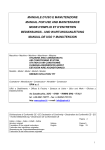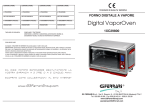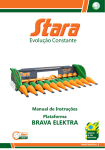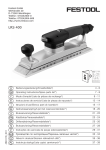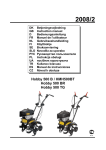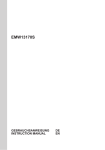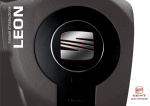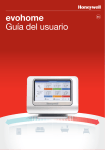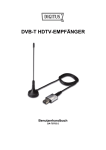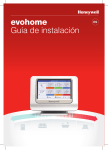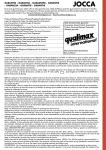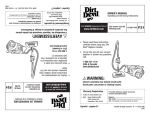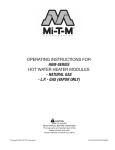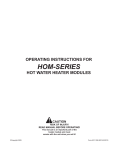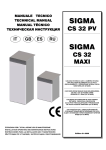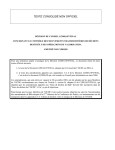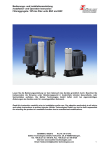Download SPIN s.r.l MANUALE D`USO E MANUTENZIONE MANUAL FOR
Transcript
SPIN s.r.l MANUALE D’USO E MANUTENZIONE MANUAL FOR USE AND MAINTENANCE MODE D’EMPLOI ET D’ENTRETIEN BETRIEBS - UND WARTUNGSANLEITUNG MANUAL DE USO Y MANTENIMIENTO ИНСТРУКЦИЯ ПО ЭКСПЛУАТАЦИИ И ОБСЛУЖИВАНИЮ Macchina • Machine • Machine • Maschinen • Máquina •Машина LAVACAMBI MANUALE PER CAMBI AUTOMATICI CLEANER AND EXCHANGER FOR AUTOMATIC GEARBOXES NETTOYEUR MANUEL DE BOITE DE VITESSE MANUELLES REINIGUNGS- UND ÖLWECHSELGERÄT FÜR AUTOMATIKGETRIEBE BANCO MANUAL DE LIMPIEZA Y SOSTITUCIÓN DEL ACEITE DE LOS CAMBIOS AUTOMÁTICOS РУЧНАЯ УСТАНОВКА ДЛЯ ЗАМЕНЫ МАСЛА И ОЧИСТКИ АКПП Modello • Model • Model • Modell • Modelo • модель ATF 2000 Costruttore • Manufacturer • Constructeur • Hersteller • Constructor • Производитель SPIN s.r.l. Uffici e Stabilimento • Office & Factory • Bureaux et Usine • Büro und Werk • Oficinas y Establecimiento • Офисы и фабрики via Casalecchio, 35G - 47851 - RIMINI (RN) - ITALY tel: ++39.0541.730777 - fax: ++39.0541.731315 http: www.spinsrl.it - e-mail: [email protected] SPIN s.r.l DICHIARAZIONE DI CONFORMITA’ CE EC - DECLARATION OF CONFORMITY DECLARATION DE CONFORMITE CE EG - KONFORMITÄTSERKLÄRUNG DECLARACION DE CONFORMIDAD CE ДЕКЛАРАЦИЯ СООТВЕТСТВИЯ ЕC SPIN srl Uffici e Stabilimento • Offices & Factory • Bureaux et Usine • Büro und Werk • Oficinas y Establecimiento • Офисы и Завод 47924 – RIMINI (RN) – ITALY – Via Casalecchio, 35/G DICHIARA il prodotto di nuova fabbricazione, descritto in appresso: DECLARES the new manufactured product, hereby described: DÉCLARE le produit de nouvelle fabrication, mentionné ci-dessous: HIERMIT erklären wir, daß das unten beschriebene Produkt neuer Herstellung: DECLARA el producto de nueva fabricación, aquí descrito: ЗАЯВЛЯЕТ, что новое изделие, описанное ниже: MODELLO • MODEL • MODÉL • MODELL • MODEL • МОДЕЛЬ • ATF 2000 LAVACAMBI MANUALE PER CAMBI AUTOMATICI MATRICOLA • SERIAL NUMBER • CODE • SERIENNUMMER • MATRÍCULA • СЕРИЙНЫЙ № _____________________________________ ANNO DI COSTRUZIONE • YEAR OF MANUFACTURE • ANNÉE DE CONSTRUCTION • HERSTELLUNGSJAHR • AÑO DE CONSTRUCCIÓN • ГОД ИЗГОТОВЛЕНИЯ _____________________________________ CONFORME, ai requisiti minimi di sicurezza ed alle disposizioni delle Direttive CE: CONFORMS, to the minimum safety requirements and to the provisions of the EC Regulation: CONFORME, aux minimales conditions de sécurité et aux dispositions des Directives CE: DEN folgenden Mindestsicherheitsanforderungen und gesetzlichen Vorschriften entspricht: CONFORME, a los requisitos mínimos de seguridad y a las disposiciones de las Directivas CE: СООТВЕТСТВУЕТ требованиям безопасности и предписаниям следующих Директив ЕС: 2006/42/CE DIRETTIVA SICUREZZA MACCHINE • MACHINERY SAFETY DIRECTIVE • DIRECTIVE DE SÉCURITÉ MACHINES • RICHTLINIE ZUR SICHERHEIT DER MASCHINEN • DIRECTIVA MÁQUINAS • ДИРЕКТИВА ПО БЕЗОПАСНОСТИ ОБОРУДОВАНИЯ 2006/95/CE DIRETTIVA BASSA TENSIONE E SUCCESSIVE MODIFICAZIONI • LOW VOLTAGE DIRECTIVE AND SUBSEQUENT AMENDMENTS • DIRECTIVE DU MATÉRIEL ÉLECTRIQUE DESTINÉ À ÊTRE EMPLOYÉ DANS CERTAINES LIMITES DE TENSION • NIE-DERSPANNUNGSRICHTLINIE MIT NACHFOLGENDEN ERGÄNZUNGEN • DIRECTIVA SOBRE EL MATERIAL ELÉCTRICO DESTI-NADO A UTILIZARSE CON DETERMINADOS LÍMITES DE TENSIÓN • ДИРЕКТИВА ПО НИЗКОМУ НАПРЯЖЕНИЮ И ЕЕ ПОСЛЕ-ДУЮЩИЕ ПОПРАВКИ Ai sensi della direttiva 2006/42/CE, la persona nominata a costituire il fascicolo tecnico, è: According to the directive 2006/42/CE, the appointed person to create the technical file is: Conformément à l’arreté 2006/42/CE, la persone désignée à la création du dossier technique est: Gemäß der Richtlinie 2006/42/CE, Bevollmächtigter für die Zusammenstellung der technischen Unterlagen ist: De conformidad con la directiva 2006/42/CE, la persona nombrada para crear la carpeta técnica es: Согласно директиве 2006/42/CE, составителем технической документации назначен: Mr. Kim 214 Konjiam-Ri, Silchon-Up, Kwangju-Si Kyunggi-Do, Korea Rimini, _______________________ Data: 01/01/2011 Ver. 01/11 Ing. Focchi Marco SPIN s.r.l IT GARANZIA La macchina è coperta da garanzia per 12 mesi dalla data della consegna purchè vengano rispettate le istruzioni riportate in questo manuale. AVVERTENZE Questo simbolo viene utilizzato quando il non rispetto o l’errata interpretazione delle istruzioni per l’uso può portare danni alle persone. • • • Ad integrazione di quanto specificato nel manuale, di seguito sono riportate ulteriori modalità di impiego della stazione: • Accompagnare la stazione durante lo spostamento e frenarla durante l’utilizzo; L’impiego in ambiente esterno deve essere limitato al tempo strettamente necessario all’esecuzione dell’operazione; Non utilizzare la stazione in presenza di atmosfera potenzialmente esplosiva; Utilizzare la stazione in ambienti protetti dalla pioggia. NOTE AMBIENTALI RUMORE La Stazione presenta un valore di Lep,d inferiore a 70 db(A). Se posta in ambienti con valore di rumorosità superiore a 80 db(A), il datore di lavoro è tenuto ad informare e formare l’operatore sui rischi derivanti dalla esposizione al rumore ed a prendere gli opportuni provvedimenti in accordo con il medico competente. IMBALLO Non gettare nella spazzatura eventuali parti di imballo, ma selezionarle a seconda del tipo di materiale (es. cartone, legno, materie plastiche, ecc.) e smaltirli in accordo alla normativa vigente locale e nazionale. FUORI SERVIZIO Alla fine della vita della Macchina è necessario: • Disattivare la Stazione, scollegandola dall’ alimentazione elettrica e tagliando il cavo di alimentazione • Smontare i componenti e selezionarli per tipo. SMALTIMENTO Alla fine della vita della Macchina è necessario smaltire i componenti, selezionati per tipo, in accordo alla normativa vigente locale e nazionale. In particolare, in merito ai componenti elettrici ed elettronici, denominati “Rifiuti di Apparecchiature Elettriche ed Elettroniche (RAEE) ai sensi del D.Lgs 151/2005 di attuazione delle direttive 2002/95/CE, 2002/96/CE e 2003/108/CE relative alla riduzione di sostanze pericolose nelle apparecchiature elettriche ed elettroniche nonché allo smaltimento dei rifiuti, il Costruttore prescrive: • Di non smaltire come rifiuto urbano e di effettuare la raccolta separata; • Informarsi presso il distributore circa i punti di raccolta autorizzati al regolare smaltimento; • Attenersi alle norme sulla corretta gestione dei rifiuti, per evitare potenziali effetti all’ambiente ed alla salute umana; • Il simbolo riportato a lato indica l’obbligo di effettuare la raccolta separata delle apparecchiature elettriche ed elettroniche al momento della rottamazione. • Il distributore che non provvede ad organizzare il sistema di raccolta separata dei RAEE professionali è punito con la sanzione amministrativa da € 30.000,00 a € 100.000,00 Data: 01/01/2011 Ver. 01/11 SPIN s.r.l MANUALE D’USO E MANUTENZIONE Indice Introduzione..................................................................................................................pag. 2 La stazione ATF 2000...................................................................................................pag. 3 I prodotti utilizzati..........................................................................................................pag. 5 Raccomandazioni iniziali...............................................................................................pag. 5 Operazioni preliminri.....................................................................................................pag. 5 Collegamento alla stazione di ricarica...........................................................................pag. 7 Schema 1 di collegamento............................................................................................pag. 9 Schema 2 di collegamento..........................................................................................pag. 10 Inserimento e messa in circolo del fluido di lavaggio..................................................pag. 11 Svuotamento circuito e rimozione della coppa olio.....................................................pag. 12 Lavaggio del radiatore.................................................................................................pag. 13 Montaggio coppa olio ed immissione olio nel circuito.................................................pag. 14 Sostituzione olio del convertitore................................................................................pag. 16 Ricollegamento...........................................................................................................pag. 16 Immissione additivo.....................................................................................................pag. 16 Controllo del livello......................................................................................................pag. 17 Rimozione dell’olio esausto dalla stazione di ricarica.................................................pag. 18 La funzione dipstick.....................................................................................................pag. 20 Recupero olio dal cambio............................................................................................pag. 22 Carica olio nuovo........................................................................................................pag. 22 Manutenzione e note finali..........................................................................................pag. 23 Data: 01/01/2011 Ver. 01/11 Pag: 1/143 IT SPIN s.r.l IT Introduzione Il presente manuale si propone di guidare gli operatori del settore in una procedura di cambio d’olio per trasmissioni automatiche valida ed affermata: questa permette la pulizia dell’intero circuito lubrificante e una rimozione integrale dell’olio esausto dall’impianto. La sostituzione del lubrificante per questo tipo di cambi è fondamentale e l’alta incidenza di guasti per quest’organo piuttosto delicato lo dimostra. Nonostante ciò, molte case costruttrici indicano la necessità di questa operazione per chilometraggi sempre maggiori, o addirittura , in alcuni casi, non ne prevedono proprio l’esigenza durante tutto il ciclo di vita della vettura. Di seguito mostriamo le immagini relative alle condizioni della coppa dell’olio di una trasmissione automatica appartenente ad una BMW serie 5 con cambio 6hp con all’attivo circa 37000 Km. Nonostante la percorrenza non affatto eccessiva della vettura, è ben visibile come si sia formata una notevole quantità di morchia e di smeriglio. L’esperienza prova, quindi, che è buona norma una sostituzione periodica con la quale è possibile rendere più fluida la marcia con meno strappi agli innesti dei vari rapporti e, allo stesso tempo, allungare la durata propria del cambio. Il miglioramento del comfort di marcia successivo al processo sotto descritto è immediatamente percepibile dal driver, il quale rimarrà sicuramente soddisfatto del lavoro effettuato. E’ per questo che consigliamo di non sottovalutare l’importanza di una regolare sostituzione dell’olio al cambio automatico. Data: 01/01/2011 Ver. 01/11 Pag: 2/143 SPIN s.r.l IT La stazione ATF 2000 Per poter effettuare il lavoro in maniera pratica e veloce ci avvaliamo dell’aiuto di una stazione di ricarica: la ATF 2000. Questa macchina, ideata appositamente per questo tipo di operazione, permette di praticare il lavoro in maniera agevole e pulita, garantendo, allo stesso tempo, un inferiore dispendio di fluido nuovo. Descrizione pannello comandi e controllo: A. Selettore “Recupero olio usato”-“ricircolo lavaggio”; B. Selettore “Carico olio nuovo/ scarico oilo usato”“ricircolo/ lavaggio”; C. Selettore ”carico olio nuovo-scarico olio esausto”; D. Flussimetri controllo stato olio nuovo-usato; E. Selettore “ricircolo”-“lavaggio”; F. Manometro pressione olio cambio; G. Tubo collegamento tanica olio nuovo; H. Filtro; I. Tanica olio nuovo; L. Indicatore livello olio usato (serbatoio olio usato interno) M. Interruttore on/off Di seguito proponiamo i set di raccordi e i tubi con i quali poter collegare svariati modelli di auto alla stazione ATF2000. Data: 01/01/2011 Ver. 01/11 Pag: 3/143 SPIN s.r.l IT Data: 01/01/2011 Ver. 01/11 Pag: 4/143 SPIN s.r.l IT I prodotti utilizzati Per il trattamento completo utilizzeremo tre prodotti (si raccomanda l’attenta verifica della compatibilità con il cambio da trattare): un additivo iniziale di lavaggio con il quale rimuovere le morchie e le emulsioni; l’olio per trasmissione automatica, con specifiche come dichiarato da casa costruttrice; ed infine un secondo additivo che permette di migliorare le performances della trasmissione. Raccomandazioni iniziali Prima di iniziare qualsiasi operazione si raccomanda l’utilizzo di dispositivi di protezione individuale (DPI) e di osservare le norme vigenti per la manipolazione e lo smaltimento dell’olio esausto Operazioni preliminari Per poter iniziare con la procedura occorre fare alcune operazioni preliminari: - guidare l’auto per alcuni minuti in modo da portare l’olio del cambio alla temperatura di regime; - innalzare l’auto tramite apposito ponte; - rimuovere eventuali carter di protezione; - ricercare la targhetta identificativa, per mezzo della quale è possibile risalire con certezza alla tipologia di cambio che si sta per trattare. Data: 01/01/2011 Ver. 01/11 Pag: 5/143 SPIN s.r.l IT - Infine individuare sulla trasmissione la mandata e il ritorno del lubrificante allo scambiatore di calore, il tappo relativo al controllo del livello dell’olio e, in conclusione, lo scarico del lubrificante. Attenzione! Quanto di seguito descritto può subire delle variazioni in funzione della tipologia di cambio che si sta per trattare. Data: 01/01/2011 Ver. 01/11 Pag: 6/143 SPIN s.r.l 1) COLLEGAMENTO ALLA STAZIONE DI RICARICA La prima operazione da eseguire è quella di collegamento del circuito alla stazione di ricarica, con la quale sarà possibile compiere il processo di svuotamento e ricarica del circuito in maniera agevole. Per fare ciò occorre utilizzare i giusti raccordi in dotazione. a) Svitare la vite di blocco della flangia di sostegno dei tubi olio e staccare il tubo di mandata del lubrificante al radiatore dell’olio precedentemente individuato. b) Installare i raccordi nell’uscita della mandata sul cambio e sul tubo di collegamento del cambio allo scambiatore di calore. 1. Collegare il condotto di giunzione nell’ingresso al cambio. 2. Inserire il raccordo di gomma nel condotto di giunzione appena inserito. 3. Collegare il raccordo con il tubo di mandata olio al radiatore. Data: 01/01/2011 Ver. 01/11 Pag: 7/143 IT SPIN s.r.l IT c) Tramite i raccordi appena posti, collegare il tubo nero all’ uscita del cambio ed il tubo trasparente alla giunzione dello scambiatore di calore. d) Per verificare se il collegamento è stato effettuato correttamente si pongano le manopole come da immagine. f) si accenda il motore e si verifichi che il flusso dell’olio circoli dalla stazione ATF verso il cambio (dal basso verso l’alto). Immediatamente dopo la verifica spegnere il motore. Data: 01/01/2011 Ver. 01/11 Pag: 8/143 SPIN s.r.l IT Schema 1: Per meglio visualizzare il corretto collegamento alla stazione di ricarica viene proposto uno schema esemplificativo. Data: 01/01/2011 Ver. 01/11 Pag: 9/143 SPIN s.r.l IT Schema 2: In alcune tipologie di cambi è possibile creare un collegamento alternativo come qui riportato. ATTENZIONE! In questo caso l’operazione di lavaggio radiatore non va eseguita! Data: 01/01/2011 Ver. 01/11 Pag: 10/143 SPIN s.r.l 2) INSERIMENTO E MESSA IN CIRCOLO DEL FLUIDO DI LAVAGGIO Con la seconda operazione si intende inserire il fluido di lavaggio nel circuito di lubrificazione della trasmissione: lo scopo è facilitare la rimozione di morchia ed emulsioni presenti le quali verranno intrappolate dal filtro della stazione ATF 2000. Dell’inserimento del liquido si può avere riscontro tramite l’ampolla di controllo. Si precisa che la stazione ATF 2000 deve essere alimentata elettricamente. a) Miscelare il fluido di lavaggio con dell’olio cambio (rapporto 1:1). b) Inserire il tubo trasparente di collegamento della stazione alla tanica posteriore, nella miscela appena prodotta utilizzando un apposito raccordo. c) Ruotare la manopole come ben esposto dall’immagine seguente e premere interruttore di alimentazione (power) per attivare la pompa; premere nuovamente l’interruttore per disattivare l’inserimento quando il contenitore del fluido si è svuotato. Data: 01/01/2011 Ver. 01/11 Pag: 11/143 IT SPIN s.r.l IT d) Ruotare le manopole come da immagine seguente. e) Accendere il motore e selezionare con la leva del cambio tutti i vari rapporti ripetutamente in modo da far aprire tutte le elettrovalvole e permettere all’additivo di lambire la totalità degli organi della trasmissione. Tramite i manometri è possibile visualizzare la pressione nelle varie marce. A volte è possibile riscontrarne un leggero incremento a seguito del lavaggio: ciò è da considerarsi indice di corretta pulizia. Per un perfetto lavaggio far durare questa operazione dai 5 ai 10 minuti a secondo del tipo di prodotto utilizzato. 3) SVUOTAMENTO CIRCUITO E RIMOZIONE DELLA COPPA OLIO Con questa operazione si inizia a rimuovere parte dell’olio vecchio. La rimozione totale si avrà solamente con le successive operazioni. Nel caso in questione la coppa integra il filtro: qualora non fosse così occorre smontare anche il filtro per la successiva sostituzione. a) Ruotare le manopole come ben chiaro dalla seguente immagine. Data: 01/01/2011 Ver. 01/11 Pag: 12/143 SPIN s.r.l b) Accendere il motore per scaricare l’olio dalla coppa: arrestare immediatamente il motore allorquando dall’ampolla sinistra (used oil) compaiono delle bolle d’aria e la pressione a manometro scende. IT c) Rimuovere la coppa svitando tutte le viti di collegamento. 4) LAVAGGIO DEL RADIATORE In questa fase facciamo in modo che l’ingresso del nuovo olio sospinga il vecchio fuori dallo scambiatore di calore. Attenzione! Qualora si fosse collegato il cambio alla stazione ATF2000 come da schema 2 questa operazione è da escludersi e continuare il processo con la successiva fase 5. a) Inserire l’olio nuovo nell’apposita tanica posta posteriormente alla stazione di ricarica. Per le quantità di olio da inserire occorre considerare le specifiche del costruttore. Data: 01/01/2011 Ver. 01/11 Pag: 13/143 SPIN s.r.l IT b) Avviare il lavaggio del radiatore lasciando le manopole invariate rispetto all’operazione precedente e premendo il l’interruttore power per attivare la pompa dell’ATF2000. c) Tramite idoneo raccoglitore d’olio esausto, recuperare il liquido in caduta. Premere l’interruttore power per interrompere il lavaggio quando il liquido in caduta risulta essere pulito. 5) MONTAGGIO COPPA OLIO ED IMMISSIONE OLIO NEL CIRCUITO a) Montare nuovamente la coppa dell’olio. Nel caso in esempio la coppa integra il filtro quindi occorre la sostituzione della stessa. Nella circostanza in cui non fosse così, è bene pulire accuratamente la coppa prima del rimontaggio e installare un nuovo filtro. Data: 01/01/2011 Ver. 01/11 Pag: 14/143 SPIN s.r.l IT b) Svitare il tappo del controllo livello olio. c) Con le manopole invariate rispetto alla fase precedente premere l’interruttore power per azionare la pompa. d) Premere nuovamente l’interruttore power per interrompere l’immissione quando all’uscita del controllo livello olio fuoriesce il fluido. Considerazioni: in questo caso la testimonianza del corretto livello di pre-riempimento è data dalla fuoriuscita del liquido dalla luce del controllo livello olio. Qualora la tipologia di cambio non permettesse tale riscontro visivo, documentarsi sulla quantità di pre-riempimento propria della trasmissione in questione da inserire. Data: 01/01/2011 Ver. 01/11 Pag: 15/143 SPIN s.r.l IT 6) SOSTITUZIONE OLIO DEL CONVERTITORE Con le manopole posizionate come la fase precedente, avviare la pompa premendo il comando power ed accendere il motore dell’auto: in questo modo l’olio va in circolo e il fluido nuovo spingerà il vecchio verso l’uscita. L’olio esausto andrà direttamente nella stazione di ricarica ed è possibile avere un riscontro visivo tramite le ampolle trasparenti: quando il colore del fluido all’interno dell’ampolla sinistra (used oil) è analogo a quello nell’ampolla destra (new oil) allora è possibile spegnere il motore e la pompa della ATF perché il processo di lavaggio è finito. Attenzione! È necessario che la quantità caricata sia uguale a quella che si sta scaricando. Controllare i due livelli (olio esausto-olio nuovo e in caso agire sul rubinetto A riducendo il flusso opportunamente). 7) RICOLLEGAMENTO Scollegare i tubi di giunzione con l’atf 2000 e ripristinare i collegamenti propri dell’auto. Questa operazione è da ritenersi l’inverso della numero uno (collegamento alla stazione di ricarica). 8) IMMISIONE ADDITIVO Con questa operazione immetteremo nel circuito l’additivo. Si tenga in considerazione che l’operazione in questione è analoga all’operazione di inserimento fluido di lavaggio vista in precedenza. a) Miscelare il fluido di lavaggio con dell’olio cambio. b) Inserire il tubo trasparente di collegamento della stazione alla tanica posteriore, nella miscela appena prodotta utilizzando un apposito raccordo. Data: 01/01/2011 Ver. 01/11 Pag: 16/143 SPIN s.r.l c) Collegare l’apposita giunzione al tubo trasparente di mandata dalla stazione. IT d) Inserire il capo libero nella luce del controllo livello olio e) Lasciare invariata la configurazione delle manopole ed azionare la pompa dell’atf 2000. premere nuovamente il pulsante power allorquando tutto il fluido è stato immesso. 9) CONTROLLO DEL LIVELLO a ) Con i collegamenti propri dell’operazione precedente, mettere l’auto in moto per effettuare il controllo del livello dell’olio. Data: 01/01/2011 Ver. 01/11 Pag: 17/143 SPIN s.r.l IT b) Con la posizione delle manopole inalterata rispetto alla fase precedente azionare la pompa dell’ATF 2000. c) Ripremere l’interruttore per disattivare la pompa quando fuoriesce liquido lubrificante dall’ingresso che stiamo utilizzando per l’immissione e chiudere il tappo del controllo livello olio. Considerazioni: qualora il cambio in questione non abbia la luce del controllo livello olio, stabilire il giusto livello come da indicazioni di casa costruttrice. Per concludere, si consiglia di eseguire un test su strada del funzionamento della vettura e ricontrollare il livello dell’olio. 10) RIMOZIONE DELL’OLIO ESAUSTO DALLA STAZIONE DI RICARICA Terminato il processo di sostituzione dell’olio trasmissione, mostriamo infine come rimuovere l’olio esausto dalla stazione di ricarica. a) Girare le manopole come indicato di seguito. Data: 01/01/2011 Ver. 01/11 Pag: 18/143 SPIN s.r.l b) Inserire il tubo trasparente (pressure) in una tanica e premere il comando principale. Premere nuovamente il comando per interrompere l’operazione allorquando tutto il fluido è stato rimosso. Data: 01/01/2011 Ver. 01/11 IT Pag: 19/143 SPIN s.r.l IT La funzione dipstick. Di seguito illustriamo la configurazione necessaria per l’utilizzo del sistema dipstick. Questa procedura può essere adoperata su cambi automatici sigillati (seal system). E’ indispensabile la presenza dell’asta per la misurazione del livello dell’olio sul cambio. Le immagini di seguito mostrano l’applicazione su di una trasmissione automatica di una mercedes classe A. Identificare il tappo dell’asta controllo olio da quest’ingresso manualmente verrà inserito l’additivo di lavaggio e il fluido per migliorare le performances del cambio. Per eseguire le operazioni di svuotamento dell’olio dalla coppa e di carica dell’olio nuovo collegare l’apposito tubo in dotazione lateralmente alla stazione di ricarica nell’ingresso della funzione dipstick e inserire l’altro capo nel cambio sino al fondo, come da immagine. Data: 01/01/2011 Ver. 01/11 Pag: 20/143 SPIN s.r.l IT Per poter utilizzare il dipstick, inoltre, è fondamentale collegare i tubi pressure e return con un raccordo maschio maschio, come da immagine. Inoltre le manopole principali devono essere tutte in posizione orizzontale, come da immagine. Data: 01/01/2011 Ver. 01/11 Pag: 21/143 SPIN s.r.l IT Recupero olio dal cambio. Nel caso di estrazione dell’olio dal cambio ruotare i rubinetti del sistema dipstick come da immagine. Premere il comando principale per azionare la pompa e ripremerlo quando nell’ampolla used oil appaiono delle bolle d’aria e la pressione del manometro scende a zero. Carica olio nuovo Per quel che concerne la carica dell’olio nuovo ruotare i rubinetti del sistema dipstick come da immagine. Premere il comando principale power per l’azionamento della pompa e ripremerlo allorquando è stata inserita nel cambio una quantità idonea. NB: le immagini di questo stampato sono fornite a titolo indicativo. Spin Srl potrà apportare in qualunque momento e senza preavviso modifiche ai modelli descritti in questo manuale per ragioni di natura tecnica o commerciale. Data: 01/01/2011 Ver. 01/11 Pag: 22/143 SPIN s.r.l IT Manutenzione Si consiglia di sostituire il filtro olio esterno periodicamente (max 7 o 8 lavaggi). Accertarsi che non vi siano perdite su tubi o raccordi, e non eseguire alcuna operazione non indicata sul presente manuale. Note finali Le immagini di questo stampato sono fornite a titolo indicativo. Spin Srl potrà apportare in qualunque momento e senza preavviso modifiche ai modelli descritti in questo stampato per ragioni di natura tecnica o commerciale. Data: 01/01/2011 Ver. 01/11 Pag: 23/143 SPIN s.r.l GUARANTEE The device is covered by a 12 month warranty from the date of delivery as long as the user complies with the instructions included in this manual EN WARNINGS This symbol is being used if the instructions of the manual are not being respected or a false interpretation of the instructions is present this can cause injuries to people. To integrate the specifications of the manual, the following use indications are reported: • Follow the station during the movement and brake it during the use; • The outside use must be limited to the strictly operation-necessary time; • Do not use the device in presence of potentially explosive atmosphere; • Use the station in rain-protected ambient. ENVIRONMENTAL NOTES NOISE The Machine presents a Lep,d value of less than 70 dB(A). If positioned in areas with a noise value of more than 80 dB(A), the employer must form and inform the operator of the risks from exposure to the noise and must take the necessary precautions according to the authorized doctor. PACKAGING Do not throw away the packaging, separate it according to the type of material (eg. cardboard, wood, plastic material, etc.) and dispose of them in conformity with the local and national laws in force OUT OF ORDER At the end of the Machine’s working life: • Deactivate the machine, by disconnecting it from the electric power supply and cutting the supply line cable; • Disassemble the components, separating the various types. DISPOSAL At the end of the Machine’s working life, the parts, separated by the type of material, had to be disposed in conformity with the local and national laws in force.For the electric and electronic devices, called Electrics and electronics Equipments (WEEE), according with EC Directives 2002/95/ CE, 2002/96/CE and 2003/108/CE, the Manufacturer specifies: • NOT dispose of the equipment as municipal waste and separate collection is mandatory; • Ask the retailer about collection points authorised for regular disposal; • Stick to the standards for correct waste management, to prevent potential effects on the environment and human health; • The onside symbol indicates that separate collection of waste electrical and electronic equipment is mandatory for scrapping. € 100.000,00 Data: 01/01/2011 Ver. 01/11 SPIN s.r.l MANUAL FOR USE AND MAINTENANCE EN Index Introduction..................................................................................................................pag. 26 The ATF 2000 station....................................................................................................pag. 27 Products utilised..........................................................................................................pag. 29 Initial recommendations..............................................................................................pag. 30 Preparatory operations...............................................................................................pag. 30 Connection to the recharging station............................................................................pag. 31 Connection diagram 1.................................................................................................pag. 33 Connection diagram 2.................................................................................................pag. 34 Insertion and circulation of the washing liquid............................................................pag. 35 Emptying the circuit and removal of the oil sump........................................................pag. 36 Washing the radiator...................................................................................................pag. 37 Mounting of the oil sump and filling the circuit with oil................................................pag. 38 Changing the converter oil..........................................................................................pag. 40 Reconnection..............................................................................................................pag. 40 Filling with additive......................................................................................................pag. 40 Checking the level.......................................................................................................pag. 41 Removal of depleted oil from the recharging station...................................................pag. 42 The dipstick function...................................................................................................pag. 44 Recovering oil from the gearbox.................................................................................pag. 46 Filling with new oil.......................................................................................................pag. 46 Maintenance and final notes.......................................................................................pag. 47 Data: 01/01/2011 Ver. 01/11 Pag: 25/143 SPIN s.r.l Introduction EN This manual is intended to guide the sector operators in a tried and true oil change procedure for automatic transmissions: this allows cleaning of the entire lubricating circuit and complete removal of the depleted oil from the system. Replacement of the lubricant for this type of gearbox is fundamental and the high occurrence of faults for this quite delicate part demonstrates as such. In spite of this, many manufacturers indicate the need for this operation at higher and higher mileages, or even in some cases, they do not anticipate the need at all for the entire duration of the vehicle’s life cycle. Below we demonstrate the images relative to the condition of the oil sump of an automatic transmission from a BMW 5 series with 6hp gearbox which has run for about 37000 Km. In spite of the vehicle mileage which is not at all excessive, it is quite visible how a significant quantity of sludge and emery has formed. Therefore experience shows that it is good practice to do a periodic oil change which makes driving smoother with less jerks upon engagement of the various speeds and, at the same time, extends the life of the transmission. The improved driving comfort following the process described below is immediately perceptible to the driver who will certainly be satisfied by the work performed. It is for this reason that we recommend not underestimating the importance of a regular automatic transmission oil change. Data: 01/01/2011 Ver. 01/11 Pag: 26/143 SPIN s.r.l The ATF 2000 station In order to perform the work in a practical and quick way, we will use the help of a recharging station: the ATF 2000. This machine, designed especially for this type of operation, allows the work to be performed in an easy and clean way, guaranteeing at the same time less waste of new oil. Description of the command and control panel: A. “Used oil recovery” - “wash recirculation” selector; B. “Load new oil / drain used oil” “recirculation / wash” selector; C. “load new oil-drain depleted oil” selector; D. new-used oil state control flowmeters; E. “recirculation” - “wash” selector; F. Transmission oil pressure manometer; G. New oil tank connection hose; H. filter; I. new oil tank; L. used oil level indicator (internal used oil tank) M. on/off switch Below is the set of connections and hoses with which various vehicle models can be connected to the ATF2000 station. Data: 01/01/2011 Ver. 01/11 Pag: 27/143 EN SPIN s.r.l EN Data: 01/01/2011 Ver. 01/11 Pag: 28/143 SPIN s.r.l Products utilised For the complete operation we will use three products (we recommend careful verification of compatibility with the transmission to be worked on): an initial washing additive which is used to remove the sludge and emulsion; automatic transmission oil with specifications as declared by the manufacturer; and finally a second additive which allows the transmission performance to be improved. Initial recommendations Before beginning any operation we recommend wearing personal protection equipment (PPE) and observing the current standards for handling or disposing of the depleted oil. Preparatory operations In order to begin the procedure a few preparatory operations must be carried out: - drive the vehicle for a few minutes in order to bring the transmission oil to running temperature; - lift the vehicle using an appropriate lift; - remove any protective panels; - look for any identification tags which would provide certain indication of the type of transmission on which we are about to work. Data: 01/01/2011 Ver. 01/11 Pag: 29/143 EN SPIN s.r.l EN - Finally, identify the lubricant send and return hoses to the heat exchanger, the oil level control cap and the lubricant drain. Attention! The information below may change depending on the type of transmission being worked on. Data: 01/01/2011 Ver. 01/11 Pag: 30/143 SPIN s.r.l 1) CONNECTION TO THE RECHARGING STATION The first operation to be performed is the connection of the circuit to the recharging station, which will facilitate the emptying and refilling of the circuit. To do this, the proper connections which are included must be utilised a) Unscrew the locking screw from the oil hoses support flange and disconnect the lubrication output hose from the previously identified oil radiator. b) Install the connector in the gearbox output and on the hose which connects the gearbox to the heat exchanger. 1. Connect the joint pipe to the gearbox intake. 2. Insert the rubber joint in the joint pipe which has just been inserted. 3. Connect the joint with the hose which goes from the output to the radiator. Data: 01/01/2011 Ver. 01/11 Pag: 31/143 EN SPIN s.r.l c) Using the joints which have just been positioned, connect the black hose to the gearbox output and the transparent hose to the heat exchanger joint. EN d) To verify whether or not the connection has been done correctly position the knobs as indicated in the image. f) turn on the engine and verify that the flow of oil circulated from the ATF station toward the gearbox (from the bottom to the top). Turn off the engine immediately after verifying. Data: 01/01/2011 Ver. 01/11 Pag: 32/143 SPIN s.r.l EN Diagram 1: In order to better view the correct connection to the recharging station, an example diagram is provided. Data: 01/01/2011 Ver. 01/11 Pag: 33/143 SPIN s.r.l EN Diagram 2: In some types of gearboxes an alternative connection can be made as shown below. ATTENTION! In this case the radiator wash operation should not be carried out! Data: 01/01/2011 Ver. 01/11 Pag: 34/143 SPIN s.r.l 2) INSERTION AND CIRCULATION OF THE WASHING LIQUID The purpose of the second operation is to introduce the washing liquid into the transmission lubrication circuit. The purpose is to facilitate removal of sludge and emulsion which will be trapped in the ATF 2000 station filter. Introduction of the liquid can be verified through the sight glass. The ATF 2000 station must be electrically powered. a) Mix the washing liquid with the transmission oil (ratio 1:1). b) Insert the station’s transparent connection hose to the rear tanks in the mixture which has just been prepared using an appropriate joint. c) Turn the knob as clearly indicated in the image below and press the power switch to activate the pump. Press the switch again to deactivate the pump when the container of oil is empty. Data: 01/01/2011 Ver. 01/11 Pag: 35/143 EN SPIN s.r.l d) turn the knob as indicated in the image below EN e) Turn on the engine and select all of the various speeds repeatedly with the gearshift lever in order to open all of the solenoid valves, allowing the additive to cover all of the components of the transmission. Using the manometer the pressure in the various speeds can be viewed. Sometimes a slight increase is noted after the wash. This should be considered an indication of correct cleaning. For perfect washing, carry out this operation for 5 to 10 minutes depending on the type of product utilised. 3) EMPTYING THE CIRCUIT AND REMOVAL OF THE OIL SUMP With this operation we begin to remove part of the old oil. The complete removal will take place only with the subsequent operations. In this case the filter is built into the sump. If this were not the case the filter would also need to be removed for subsequent replacement. a) Turn the knob as clearly indicated in the image below. Data: 01/01/2011 Ver. 01/11 Pag: 36/143 SPIN s.r.l b) Turn on the engine to drain the oil from the sump. Immediately stop the engine when in the left sight glass (used oil) air bubbles appear and the pressure on the manometer drops. EN c) Remove the sump unscrewing all of the connection screws 4) WASHING THE RADIATOR In this step we will make the introduction of the new oil push the old out of the heat exchanger. Attention! If connection to the ATF2000 has been done following diagram 2 this operation should be skipped and you should proceed directly to step 5. a) Introduce the new oil into the appropriate tank located at the rear of the recharging station. For the quantities of oil to be introduced, the manufacturer’s specifications must be considered. Data: 01/01/2011 Ver. 01/11 Pag: 37/143 SPIN s.r.l b) Start the radiator wash leaving the knobs unchanged with respect to the previous operation and pressing the power switch to activate the ATF2000 pump. EN c) using an appropriate depleted oil container, recover the oil which drains out. Press the power switch to interrupt the wash when the liquid draining out is clean. 5) MOUNTING OF THE OIL SUMP AND FILLING THE CIRCUIT WITH OIL a) Remount the oil sump. In our example the filter is built into the sump, therefore it must be replaced. If this is not the case, the sump should be carefully cleaned before remounting and a new filter should be installed. Data: 01/01/2011 Ver. 01/11 Pag: 38/143 SPIN s.r.l b) Unscrew the oil level check cap EN c) With the knobs unchanged with respect to the previous steps press the power switch to activate the pump. d) Press the power switch again to interrupt the operation when oil comes out of the oil level check. Considerations: in this case the indication of the correct pre-filling level is the overflow of the liquid from the top of the oil level check. If the type of transmission does not allow this type of visual confirmation, research the pre-fill quantity of the transmission in question. Data: 01/01/2011 Ver. 01/11 Pag: 39/143 SPIN s.r.l 6) CHANGING THE CONVERTER OIL EN With the knobs positioned in the same way as the previous steps start the pump by pressing the power command and turn on the vehicle engine. This way the oil goes into circulation and the new fluid will push the old to the drain. The depleted oil will go directly into the recharging station and this can be visually verified through the transparent sight glass. When the colour of the fluid in the left sight glass (used oil) is similar to that in the right gauge (new oil) the engine can be switched off and the ATF pump deactivated because the wash process is complete. Attention! The quantity filled must be the same as that which is being drained. Check the two levels (depleted oil-new oil and if necessary use tap A to appropriately reduce the flow). 7) RECONNECTION Disconnect the connection hoses with the ATF 2000 and restore the vehicles connections. This operation should be carried out following the indications in step number one in reverse (connection to the recharging station). 8) FILLING WITH ADDITIVE With this operation we will introduce the additive into the circuit. It should be borne in mind that the operation in question is similar to the fluid introduction operation which was seen previously. a) Mix the washing liquid with the transmission oil. b) Insert the station’s transparent connection hose to the rear tanks in the mixture which has just been prepared using an appropriate joint. Data: 01/01/2011 Ver. 01/11 Pag: 40/143 SPIN s.r.l c) connection the appropriate joint to the transparent output hose from the station. EN d) insert the free end of the hose in the mouth of the oil level check e) leave the configuration of the knobs the same and activate the ATF 2000 pump. Press the power switch again when all of the fluid has been introduced. 9) CHECKING THE LEVEL a) With the vehicle’s connection from the previous step start the engine to check the oil level. Data: 01/01/2011 Ver. 01/11 Pag: 41/143 SPIN s.r.l b) with the position of the knobs unchanged with respect to the previous steps activate the ATF 2000 pump. EN c) Press the switch again to deactivate the pump when the lubrication fluid overflows from the intake which we are using to introduce it and close the cap of the oil level check. Considerations: if the transmission in question does not have an oil level check opening, establish the correct level as indicated by the manufacturer. In conclusion, we recommend performing an operational road test of the vehicle and then checking the oil level again. 10) REMOVAL OF THE DEPLETED OIL FROM THE RECHARGING STATION. Once the transmission oil change process is completed, we will demonstrate how to remove the depleted oil from the recharging station. a) Turn the knobs as indicated below. Data: 01/01/2011 Ver. 01/11 Pag: 42/143 SPIN s.r.l b) Insert the transparent hose (pressure) into a tank and press the main command. Press the command again to interrupt the operation when all of the fluid has been removed. EN Data: 01/01/2011 Ver. 01/11 Pag: 43/143 SPIN s.r.l The dipstick function EN Below we will illustrate the configuration necessary to utilise the dipstick system. This procedure can be implemented on sealed automatic transmissions (seal system). The presence of the oil dipstick on the transmission is indispensable. The images below show the application on an automatic transmission in a Mercedes A class. Identify the oil dipstick cap.The washing additive will be manually introduce into this opening to improve transmission performance. To carry out the oil emptying and refilling operations with new oil connect the included hose on the side of the recharging station into the dipstick opening and insert the other end into the transmission all the way to the bottom as indicated in the image. Data: 01/01/2011 Ver. 01/11 Pag: 44/143 SPIN s.r.l EN In order to use the dipstick it is also fundamental that the pressure and return hoses are connected with a male-male joint as shown in the image. Also, the main knobs must all be in the horizontal position as shown in the image. Data: 01/01/2011 Ver. 01/11 Pag: 45/143 SPIN s.r.l Recovering oil from the gearbox EN In case of extraction of the oil from the gearbox turn the dipstick system taps as shown in the image. Press the main command to activate the pump and press it again when air bubbles appear in the used oil sight glass and when the manometer pressure drops to zero. Filling with new oil To fill with new oil, turn the dipstick system taps as shown in the image. Press the main power command to activate the pump and press it again when an appropriate quantity has been introduced. Note: the images shown here are provided strictly as examples. Spin Srl may make changes at any time to the models described in this manual for technical or commercial reasons without any advance notice. Data: 01/01/2011 Ver. 01/11 Pag: 46/143 SPIN s.r.l Maintenance We recommend replacing the external oil filter periodically (max 7 or 8 washes). Ensure that there are no leaks from the hoses or joints and do not perform any operation which is not indicated in this manual. Final notes The images shown here are provided strictly as examples. Spin Srl may make changes at any time to the models described in this document for technical or commercial reasons without any advance notice. Data: 01/01/2011 Ver. 01/11 Pag: 47/143 EN SPIN s.r.l GUARANTEE La machine possède une garantie de 12 mois de la date de livraison à condition que les instructions reportées sur ce manuel soient respectées. WARNINGS Ce symbole indique que le non-respect ou la mauvaise interprétation des instructions peut provoquer le danger à les utilisateurs. FR • • • • Pour completer ce qui décrit dans le manuel, ci-dessous il seront cités les modalités nécessaires pour l’utilisation de la station: Accompagner la station pendant son déplacement et blocquer les roues pendant le travail; l’utilisation en plein air doit être limité au temps nécessaire pour l’execution de l’opération; Ne pas utiliser la station dans l’mabiance potentiellement explosive; N’utilisez pas la station sous le pluie. ENVIRONMENTAL NOTES BRUIT La Station présente une valeur en Lep,d inférieure à 70 db(A). Si elle est placée dans les milieux où la valeur de bruit est supérieure à 80 dB(A), l’utilisateur est obligé à informer l’opérateur sur les risques causés par un tell bruit et à prendre des mesures appropriées en consultant le médecin compétent. EMBALLAGE En jettant à la poubelle les parties d’emballage, sélectionnez-les par type du matériel (ex. Carton, bois, pastique, etc) et traitez-les conformément aux normes locales et nationales en vigueur. HORS SERVICE Lorsque la machine est défintivement hors d’usage, il est nécessaire de: • Eteindre la station en la débranchant de réseau d’alimentation électrique et en coupant le câble d’alimentation; • Démonter les pièces, sélectionnez-les par type. DÉMANTÈLEMENT Pour démanteler la station à la fin de sa vie il est nécessaire de détruire les components, sélectionnée par type, conformément aux normes locales et nationales en vigueur conformément aux normes locales et nationales en vigueur. En particulier, en ce qui concerne les components électriques et électroniques, només “Déchets d’Équipements Électriques et Électroniques (DEEE) aux termes de la directive CE 2002/95/CE, 2002/96/CE et 2003/108/CE, le Costructeur prescrit: • NE PAS ELIMINER cet appareil comme un déchet urbain mais effectuez le tri sélectif de ses composants; • S’informer auprès le révendeur sur les centres de collectage autorisés au tri et au traitement de ce type de déchet; • Respecter les normes sur la gestion des déchets pour éviter tout risque de nuisances à l’environnement et à la santé de personnes; • Le symbole à coté, indique la nécessité d’effectuer le tri sélectif des appareils électriques et électroniques au moment de leur démantèlement. Data: 01/01/2011 Ver. 01/11 SPIN s.r.l MODE D’EMPLOI ET D’ENTRETIEN Index FR Introduction..................................................................................................................pag. 50 La station ATF 2000.....................................................................................................pag. 51 Les produits utilisés....................................................................................................pag. 52 Recommandations initiales.........................................................................................pag. 51 Opérations préliminaires.............................................................................................pag. 51 Raccordement à la station de recharge........................................................................pag. 55 Schéma 1 de raccordement........................................................................................pag. 57 Schéma 2 de raccordement........................................................................................pag. 57 Introduction et mise en circuit du fluide de lavage.....................................................pag. 57 Vidange du circuit et dépose du carter d’huile............................................................pag. 60 Lavage du radiateur....................................................................................................pag. 61 Montage du carter et introduction de l’huile dans le circuit........................................pag. 62 Remplacement huile du convertisseur........................................................................pag. 64 Rétablissement des raccordements...........................................................................pag. 64 Introduction additif.......................................................................................................pag. 64 Contrôle du niveau.....................................................................................................pag. 65 Dépose de l’huile usée de la station de recharge.......................................................pag. 66 La fonction dipstick......................................................................................................pag. 68 Récupération de l’huile de la boîte de vitesses...........................................................pag. 70 Remplissage nouvelle huile........................................................................................pag. 70 Manutention et observations finales...........................................................................pag. 71 Data: 01/01/2011 Ver. 01/11 Pag: 49/138 SPIN s.r.l Introduction Ce manuel se propose de guider les opérateurs du secteur dans une procédure valable et soutenue pour le remplacement de l’huile des transmissions automatiques: celle ci permet le nettoyage de tout le circuit lubrifiant et l’élimination intégrale de de l’huile usée du système. FR Le remplacement du lubrifiant pour ce type de boîte de vitesses est déterminant et l’incidence élevée des inconvenients rencontrés sur cet organe assez délicat le démontre. Malgré ceci , plusieurs constructeurs indiquent la nécéssité de cette opération à des kilométrages toujours plus élevés et dans certains cas n’en prévoient même pas l’exigence durant tout le cycle vital de l’automobile. Nous montrons ci-après les images relatives aux conditions du carter d’huile d’une transmission automatique d’un véhicule BMW série 5 avec boîte de vitesse 6hp ayant parcouru 37000 Km. Malgré le kilométrage non particulièrement excessif ,la formation d’une importante quantité de cambouis et émeri est bien visible. En effet, l’expèrience prouve qu’il est conseillé d’éffectuer la vidange de l’huile périodiquement car cela permet, de rendre plus fluide le déroulement sans accrocs à l’enclenchement des divers rapports, et en même temps de préserver la durée de la boîte de vitesses. L’amélioration du confort de conduite successif au procédé ci-après décrit sera immédiatement perceptible de la part du conducteur qui restera sûrement satisfait de l’intervention éffectuée. Nous conseillons donc de ne pas sous estimer l’importance d’une régulière vidange de l’huile de la boîte de vitesses automatique. Data: 01/01/2011 Ver. 01/11 Pag: 50/143 SPIN s.r.l La station ATF 2000 Pour pouvoir éffectuer le travail d’une manière pratique et rapide nous utiliserons la station de recharge ATF 2000. Cet appareil.projeté exprès pour ce type d’opération,permet d’éffectuer un travail facile et propre tout en garantissant une réduction du gaspillage du fluide. Description tableau de commandes et contrôle : A. Selecteur”Récupération huile usée”-“Recyclage lavage” B. Selecteur”Chargement huile neuve/ déchargement huile usée “Recyclage/lavage” C. Selecteur ”Chargement huile neuve/ déchargement huile épuisée” D. Fluxmètres,controle état huile neuve-usée E. Selecteur “Recyclage”-“lavage” F. Manomètre pression huile boîte de vitesses G. Tuyau de jonction à la jerricane d’huile neuve H. Filtre I. Jerricane huile neuve L. Indicateur niveau huile usée (réservoir huile usée interne) M. Interrupteur on/off FR Nous proposons ci-après les séries de raccords et tubes avec lesquels il est possible connecter différents modèles de voiture à la station ATF 2000. Data: 01/01/2011 Ver. 01/11 Pag: 51/143 SPIN s.r.l FR Data: 01/01/2011 Ver. 01/11 Pag: 52/143 SPIN s.r.l Les produits utilisés Pour le traîtement complet nous utiliserons trois produits (il est recommandé de vérifier attentivement leur compatibilité avec la boîte de vitesses): un additive initial de lavage pour éliminer le cambouis et les émulsions , l’huile de transmission automatique correspondante aux. Indications du constructeur,et enfin un second additif qui permet d’améliorer les performances de la boîte de vitesses. FR Recommandations initiales Avant de commencer n’importe quelle opération il est recommandé d’utiliser les dispositifs de protection individuelle (DPI) et observer les normes in vigueur pour la manipulation et l’évacuation des huiles de vidange. Opérations préliminaires Pour pouvoir procéder il est nécéssaire d’éffectuer quelques opérations préliminaires: - Conduire le véhicule pendant quelques minutes afin que l’huile de la boîte de vitesses atteigne la température de régime; - Soulever l’automobile avec un pont approprié; - Déposer éventuel carter de protection; -Rechercher la plaquette d’identification avec laquelle il est possible de retracer en toute certitude Le type de la boîte de vitesses en question. Data: 01/01/2011 Ver. 01/11 Pag: 53/143 SPIN s.r.l FR - Enfin, repérer sur la transmission l’arrivée et le retour du lubrifiant à l’échangeur de chaleur,le bouchon relatif au contrôle du niveau de l’huile et ,pour conclure, la décharge du lubrifiant. Attention! Les opérations ci-après décrittes peuvent subir des variations en fontion du type de boite de vitesses à vidanger. Data: 01/01/2011 Ver. 01/11 Pag: 54/143 SPIN s.r.l 1) RACCORDEMENT A LA STATION DE RECHARGE La première opération à éffectuer est celle de raccorder le circuit à la station de recharge avec laquelle il sera alors possible d’accomplir facilement le procédé de décharge et recharge du circuit .Pour faire cela, il est nécéssaire de faire usage des raccords appropriés en dotation. a) Dévisser la vis de bloccage de la flange de retenue des tubes de l’huile et détacher le tube de d’arrivée du lubrifiant au radiateur d’huile, précédement identifié. FR b) Disposer les raccords à la sortie de l’arrivèe sur la boîte de vitesses et sur le tube de raccrodement de la boîte à l’échangeur de chaleur 1) Connecter la conduite de jonction à l’entrée de la boîte 2) Introduire le raccord en caoutchouc dans la conduite de Jonction insérée auparavent. 3) Relier le raccord avec le tube d’arrivée de l’huile au radiateur Data: 01/01/2011 Ver. 01/11 Pag: 55/143 SPIN s.r.l c) A travers les raccords déjà installés,relier le tuyau noir à la sortie de la boîte de vitesses et le tuyau transparent à la jonction de l’échangeur de chaleur. FR d) Pour vérifier que le raccordement a été correctement éffectué on dispose tout d’abord les boutons de commande comme indiqué sur les images ci-après: f) Mettre en marche le moteur et vérifier que le flux de l’huile circule de la station ATF vers la boîte de vitesses (de bas en haut).Immédiatement après ce contrôle arrêter le moteur. Data: 01/01/2011 Ver. 01/11 Pag: 56/143 SPIN s.r.l Schéma 1: Pour mieux visualiser le parfait raccordement à la station de recharge nous proposons ci-après un exemple schématique. Data: 01/01/2011 Ver. 01/11 Pag: 57/143 FR SPIN s.r.l Schéma 2: FR Dans certains types de boîtes de vitesses il est possible de créer un raccordement Comme ci-dessous reporté. ATTENTION! Dans ce cas l’opération de lavage du radiateur ne doit pas être éffectuée. Data: 01/01/2011 Ver. 01/11 Pag: 58/143 SPIN s.r.l 2) INTRODUCTION ET MISE EN CIRCUIT DU FLUIDE DE LAVAGE Avec la seconde opération on introduit le fluide de lavage dans le circuit de lubrification de la transmission: le but est de faciliter l’élimination du cambouis et des émulsions présents qui serons retenus par le filtre de la station ATF 2000. L’introduction du liquide peut ètre vèrifiée à travers le témoin de controle . La station ATF 2000 doit être alimentée electriquemen a) Mélanger le fluide de lavage avec l’huile boîte de vitesses (Rapport 1:1). FR b) Introduire le tuyau transparent de raccordement de la station, en utilisant le raccord approprié, à la jerricane postérieure contenant le mélange précédemment produit . c) Tourner le bouton de commande comme démontré par l’image suivante et appuyer l’interrupteur d’alimentation (power) pour activer la pompe; appuyer de nouveau l’interrupteur pour stopper la pompe lorsque le recipient du fluide s’est vidé. Data: 01/01/2011 Ver. 01/11 Pag: 59/143 SPIN s.r.l d) Tourner les boutons de commande comme indiqué par les images suivantes: FR e) Mettre en marche le moteur et sélectionner plusieur fois, avec le levier de vitesses, tous les rapports afin de provoquer l’ouverture de toutes les electro-valves et permettre au produit additif d’atteindre les organes de la transmission .A travers les manomètres il est possible de visualiser la pression dans les différents rapports de vitesse.Il est parfois possible de noter un léger accroissement de la pression, ceci est à considérer comme indice d’un bon nettoyage. Pour obtenir un lavage optimal laisser durer l’opération de 5 à 10 minutes selon le type de produit utilisé. 3) VIDANGE CIRCUIT E DEMONTAGE CARTER HUILE Cette première opération consiste à enlever partiellement l’huile usée. L’enlèvement total s’obtiendra seulement avec les opérations successives. Dans le cas en question le carter incorpore le filtre: sinon, il est aussi nécéssaire de démonter le filtre et procéder a son remplacement. a) Tourner les boutons de commade comme indiqué sur les images suivantes: Data: 01/01/2011 Ver. 01/11 Pag: 60/143 SPIN s.r.l b) Mettre en marche le moteur pour décharger l’huile du carter: Arrèter immediatement le moteur du moment où dans le témoin gauche de niveau apparaissent des bulles d’air et que la pression au manomètre diminue. FR c) Démonter le carter en dévissant toutes les vis de fixation. 4) LAVAGE DU RADIATEUR Dans cette phase nous ferons en sorte que l’huile neuve pousse l’huile usée à l’extérieur de l’èchangeur de chaleur. Attention! Dans le cas où la boîte de vitesses est raccordée à la station ATF 2000 comme prévu sur le Schéma 2 exclure cette opèration et continuer selon les instructions de la phase 5 successive. a) Verser l’huile neuve dans le récipient approprié situé derriére la station de recharge. En ce qui concerne les quantités d’huile à introduire il est nécéssaire de consulter les spécifications fournies par le constructeur. Data: 01/01/2011 Ver. 01/11 Pag: 61/143 SPIN s.r.l b) Actionner le lavage du radiateur en laissant inchangée la position des boutons de commande par rapport à l‘opération précédente et appuyer l’interrupteur power pour mettre en fonction la pompe de l’ATF 2000. FR c) Au moyen d’un récipient approprié aux huiles usées récupérer le liquide en chute. Appuyer l’interrupteur power pour interrompre le lavage du moment où le liquide résulte propre. 5) MONTAGE CARTER D’HUILE ET INTRODUCTION HUILE DANS LE CIRCUIT a) Monter à nouveau le carter d’huile. Dans le cas cité en exemple le filtre est intégré au carter et il est donc nécéssaire d’effectuer le remplacement de ce dernier,sinon il faut nettoyer soigneusement le carter avant de le remonter et installer un filtre neuf. Data: 01/01/2011 Ver. 01/11 Pag: 62/143 SPIN s.r.l b) Dévisser le bouchon de controle niveau de l’huile FR c) Maintenir inchangée la position des boutons de commande par rapport à la phase précédente et appuyer l’interrupteur power pour actionner de la pompe. d) Appuyer à nouveau l’interrupteur power pour interrompre l’introduction dès que le fluid fuit de la sortie du contrôle niveau. Considérations: La sortie du liquide, à partir de l’ouverture de controle du niveau de l’huile,témoigne le correct niveau de pré-remplissage.Si le type de boîte de vitesses ne permet pas un tel contrôle visuel,veuillez vous documenter sur la quantité de liquide de préremplissage utile pour la transmission en question. Data: 01/01/2011 Ver. 01/11 Pag: 63/143 SPIN s.r.l 6) REMPLACEMENT HUILE DU CONVERTISSEUR FR Maintenir les commandes comme précédemment disposées, activer la pompe en appuyant le bouton power et mettre en marche le moteur du véhicule pour permettre à l’huile d’aller dans le circuit et pousser l’huile usée vers la sortie. L’huile usée est directement convoyée dans la station de recharge et il est possible avoir un contrôle visuel à travers les regards transparents: Si la couleur du fluide à l’intérieur de la burette gauche(used oil) est semblable à celle de la burette droite (new oil) on doit alors arrèter le moteur car le processus de lavage est terminè. Attention!Il est nécéssaire que la quantité chargée soit égale à celle en cours de déchargement.Contrôler les deux niveaux(huile usée-huile neuve et au cas utiliser le robinet A pour réduire opportunément le flux). 7) DEBRANCHEMENT DES RACCORDEMENTS Débrancher les tuyaux raccordés à l’ATF 2000 et rétablir les raccordements propres à l’auto. Cette opération est considérée inverse de celle du numero 1 (Raccordement à la station de recharge) 8) INTRODUCTION ADDITIF Cette opération permet d’introduire l’additif dans le circuit. Il est à signaler que l’opération en question est comparable à celle de l’introduction du fluide de lavage décritte auparavent. a) Mélanger l’additif avec l’huile de la boîte de vitesses b) Introduire, en utilisant le raccord approprié, le tuyau transparent de raccordement de la station à la jerricane postérieure contenant le mélange produit précédemment. Data: 01/01/2011 Ver. 01/11 Pag: 64/143 SPIN s.r.l c) Relier la jonction appropriée au tuyautransparent de propulsion de la station FR d) Insérer l’extrémité libre du tuyau dans l’ouverture du contrôle de niveau e) Laisser inchangé la configuration des boutons de commande et mettre en fonction la pompe del’ATF 2000.Appuyer de nouveau la commande power jusqu’à ce que le fluide soit introduit. 9) CONTROLE DU NIVEAU a ) Avec les mêmes raccordements de l’opération précédente,mettre le moteur en marche pour éffectuer le côntrole du niveau d’huile. Data: 01/01/2011 Ver. 01/11 Pag: 65/143 SPIN s.r.l b) Maintenir la position des boutons de commande inchangée par rapport à la phase précédente et actionner la pompe de l’ATF 2000 FR c) Appuyer une nouvelle fois l’interrupteur pour disactiver la pompe dès que le liquide lubrifiant fuit par l’ouverture utilisée pour le remplissage, et fermer le bouchon de controle du niveau d’huile. Considérations: Au cas où la boîte de vitesses en question ne dispose pas d’ouverture pour le contrôle du niveau de l’huile,respecter le niveau selon les intructions du constructeur. Pour terminer,il est conseillé d’éffectuer une épreuve de fonctionnement du véhicule sur route et contrôler à nouveau le niveau de l’huile 10) DÉPOSE DE L’HUILE USÉE DE LA STATION DE RECHARGE Une fois terminé l’opération de remplacement de l’huile de transmission,voici les indications à suivre pour l’élimination de l’huile usée de la station de recharge. a) Tourner les boutons de commande comme suit: Data: 01/01/2011 Ver. 01/11 Pag: 66/143 SPIN s.r.l b) Introduire le tuyau transparent (pressure) dans un récipient et appuyer le bouton de commande principal.Appuyer de nouveau le bouton pour interrompre l’opération dès que le fluide résulte complètement évacué. FR Data: 01/01/2011 Ver. 01/11 Pag: 67/143 SPIN s.r.l La Fonction Dipstick Nous indiquons ci-après la méthode d’emploi du. système dipstick.Ce procédé peut être utilisé sur les boîtes de vitesses automatiques scellèes (seal system).Dans ce cas la présence de la jauge à huile pour le contrôle de niveau est indispensabile FR Les images ci-aprés démontrent l’application sur la transmission automatique d’une Mercedes classe A. Identifier le bouchon de la jauge de contrôle niveau de l’huile et à partir de cette ouverture verser l’additif de lavage et le fluide pour améliorer les performances de la boîte de vitesses. Pour éffectuer les opérations de vidange de l’huile du carter et de remplissage de la nouvelle huile,raccorder le tuyau approprié ,en dotation, sur le coté de la station de recharge à l’entrée de la fonction dipstick , et introduire l’autre bout jusqu’au fond de la boîte de vitesses (voir image) Data: 01/01/2011 Ver. 01/11 Pag: 68/143 SPIN s.r.l FR Pour pouvoir utiliser le dipstick,il est d’autre part indispensable joindre les tuyaux “pressure”et “return” avec un raccord mâle (Voir image). En outre tous les boutons de commande doivent se trouver en postion horizontale(voir image ci-dessous.) Data: 01/01/2011 Ver. 01/11 Pag: 69/143 SPIN s.r.l Récupération de l’huile de la boite de vitesses FR Pour extraire l’huile de la boîite de vitesses,tourner les robinets du système dipstick comme indiqué sur la foto).Appuyer la commande principale pour actionner la pompe et appuyer de nouveau dès que des bulles d’air apparaissent dans la burette transparente et que la pression signalée au manometre descend à zero. Charge de l’ huile neuve Pour charger l’huile neuve,tourner les robinets du système dipstick comme indiqué sur la foto et appuyer la commande principale power pour actionner la pompe .Une fois introduite la quantité nécéssaire,appuyer de nouveau la commande principale.. NB: les images représentées sur cette documentation sont fournies à titre indicatif. Spin Srl se réserve le droit de pouvoir éffectuer, à n’importe quel moment et sans préavis ,des modifications aux modèles décrits sur ce manuel pour des raisons de nature technique où commerciale. Data: 01/01/2011 Ver. 01/11 Pag: 70/143 SPIN s.r.l Entretien Il est conseillé de remplacer périodiquement le filtre à huile extérieur ( max 7 a 8 lavages) S’assurer qu’il ne persiste aucune fuite d’huile aux tuyaux ou raccords, et n’éffectuer aucune autre operation si non indiquée sul le présent manuel. Annotations finales Les images représentées sur cette documentation sont fournies à titre indicatif. Spin Srl se réserve le droit de pouvoir éffectuer, à n’importe quel moment et sans préavis, des modifications aux modèles décrits sur ce manuel pour des raisons de nature technique où commerciale Data: 01/01/2011 Ver. 01/11 Pag: 71/143 FR SPIN s.r.l GARANTIE Das Gerät hat eine 12-monatige Garantiezeit gültig ab Lieferdatum, unter Beachtung der Vorschriften der vorliegenden Bedienungsanleitung. WARNUNG Dieses Symbol wird benutzt wenn die Instruktionen der Bedienungsanleitung nicht respektiert werden oder eine falsche Interpretation der Instruktionen vorliegt kann dies zur Verletzung von Personen führen. Zur Anleitung integriert, zeigen wir die folgende Gebrauchsanleitungen an: • DE • • • begleiten Sie das Gerät während dem Verschieben und bremsen Sie das Gerät während Gebrauch; benutzen Sie das Gerät draußen nur für die strengstens benötigte Zeit; benutzen Sie nicht das Gerät in potenziell explosiver Umgebung; benutzen Sie das Gerät in von Regen geschützten Räume. UMWELTINFORMATIONEN GERÄUSCHE Der Station entwickelt einen Geräuschpegel von unter 70 db(A). In Arbeitsumgebungen, in denen ein Geräuschpegel von mehr als 80 dB(A) entsteht, hat der Arbeitgeber den Arbeitnehmer über das bestehende Risiko zu informieren und Schutzmaßnahmen nach Absprache mit dem zuständigen Arzt zu treffen. VERPACKUNG Die Verpackung sollte nach Materialien sortiert werden (Pappkarton, Holz, Plastik) und getrennt nach den bestehenden nationalen Gesetzen entsorgt werden. AUßER BETRIEB Am Ende des Arbeitslebens der Station: • Setzen Sie der Station außer Betrieb, indem Sie den Stecker aus der Steckdose ziehen und das Kabel abschneiden; • Montieren Sie die verschiedenen Komponenten ab, welche nach Typen sortiert und nach den örtlichen und nationalen Gesetzen entsorgt werden müssen. ENTSORGUNG Am Ende des Arbeitslebens der Station, sollen Sie die Komponenten nach Typ selektieren und dann entsorgen; folgen Sie die geltend nationale und örtliche Normen. Ins besondere, in Bezug auf elektrische und elektronische Komponenten, genant “Elektro- und ElektronikAltgeräte (EEA)“, bei Richtlinien CE 2002/95/CE, 2002/96/CE und 2003/108/CE, der Hersteller vorschreibt: • Das Gerät darf NICHT als Hausmüll entsorgt werden, sondern muss dem Sondermüll zugeführt werden; • Informieren Sie sich bei Ihrem Händler über die Müllsammelzentren, die zur ordnungsgemäßen Entsorgung befugt sind ; • Befolgen Sie die Richtlinien für die ordnungsgemäße Behandlung von Müll, um mögliche Gefahren für die Umwelt und für die Gesundheit zu vermeiden; • Dieses Symbol zeigt an, dass es Pflicht ist, elektrische und elektronische Geräte nach der Verschrottung dem Sondermüll zuzuführen. Data: 01/01/2011 Ver. 01/11 SPIN s.r.l BETRIEBS - UND WARTUNGSANLEITUNG Inhaltsverzeichnis Einführung.......................................................................................................................s. 74 Die Ladestation ATF 2000..............................................................................................s. 75 Die verwendeten Produkte..............................................................................................s. 77 Empfehlungen zu Beginn................................................................................................s. 77 Vorbereitende Arbeiten....................................................................................................s. 77 Anschluss an die Ladestation............................................................................................s. 79 Schema 1........................................................................................................................s. 81 Schema 2........................................................................................................................s. 82 Einfüllung und Verteilung der Spülflüssigkeit..................................................................s. 83 Entleerung des Kreislaufs und Entnahme der Ölwanne.................................................s. 84 Spülung des Ölkühlers....................................................................................................s. 85 Anbringung der Ölwanne und Eingabe des Öls in den Kreislauf....................................s. 86 Ölwechsel am Wandler....................................................................................................s. 88 Wiederanschluss.............................................................................................................s. 88 Eingabe des Zusatzstoffs................................................................................................s. 88 Füllstandskontrolle..........................................................................................................s. 89 Entfernung des Altöls aus der Ladestation......................................................................s. 90 Die Dipstick-Funktion......................................................................................................s. 92 Sammlung des Altöls aus dem Getriebe.........................................................................s. 94 Einfüllung von Neuöl.......................................................................................................s. 94 Wartung und Schlussbemerkungen................................................................................s. 95 Data: 01/01/2011 Ver. 01/11 S: 73/143 DE SPIN s.r.l Einführung Dieses Handbuch soll Beschäftigten in der Branche als Anleitung für ein erprobtes und wirksames Ölwechselverfahren für Automatikgetriebe dienen: Dank dieses Verfahrens können die Säuberung des gesamten Schmierkreislaufes und eine vollständige Entfernung des Restöls aus der Anlage erreicht werden Die Auswechslung des Schmiermittels ist bei diesem Typ von Getrieben fundamental, was sich nicht zuletzt am hohen Aufkommen von Defekten an diesem sehr sensiblen Maschinenteil zeigt. Nichtsdestotrotz sind viele Hersteller der Ansicht, dieses Verfahren auf eine immer größere Kilometeranzahl veranschlagen zu können oder sehen es gar für den gesamten Lebenszyklus des Fahrzeugs als nicht erforderlich an. DE Auf den folgenden Abbildungen möchten wir Ihnen das Aussehen einer Ölwanne eines Automatikgetriebes in einem BMW-5er mit 6hp-Getriebe und einem Kilometerstand von etwa 37.000 km zeigen. Trotz des relativ geringen Kilometerstands kann man hier gut erkennen, wie sich eine erhebliche Menge an Ölschlamm und Schmirgel gebildet hat. Die Erfahrung lehrt also, dass ein regelmäßiger Wechsel zu einem geschmeidigeren Einrasten des Gangs mit weniger ruckartigen Bewegungen an den Kupplungen der verschiedenen Gänge führt und gleichzeitig die Lebenszeit des Schaltgetriebes selbst verlängert. Der erhöhte Komfort beim Schalten im Gefolge des unten beschriebenen Verfahrens kann vom Fahrer sofort nachempfunden werden und wird zu seiner vollsten Zufriedenheit ausfallen. Aus diesem Grund raten wir Ihnen, die Wichtigkeit eines regelmäßigen Ölwechsels bei Automatikschaltung nicht zu unterschätzen. Data: 01/01/2011 Ver. 01/11 S: 74/143 SPIN s.r.l Die Ladestation ATF 2000 Um den Ölwechsel auf praktische und schnelle Weise durchführen zu können, greifen wir auf die Dienste einer Ladestation zurück: die ATF 2000. Diese Maschine wurde eigens für dieses Verfahren entworfen und erlaubt es, die Arbeit auf bequeme und schnelle Art auszuführen und gleichzeitig einen geringeren Verbrauch an neuem Arbeitsmedium zu erzielen. Beschreibung des Schalt- und Steuerungspults: A. Auswahlschalter “Auffangen des Altöls”“Wiederumlauf Reinigung”; B. Auswahlschalter “Befüllung mit Neuöl/ Ablauf Altöl”-“Wiederumlauf/ Spülung”; C. Auswahlschalter “Befüllung mit neuem Öl Ablauf verbrauchtes Öl”D. Durchflussmesser zur Kontrolle Füllstand NeuölAltöl; E. Auswahlschalter “Wiederumlauf” / “Spülung”; F. Druckmesser Getriebeöldruck; G. Verbindungsschlauch Neuöl-Kanister; H. Filter; I. Neuöl-Kanister; L. Füllstandanzeige Altöl (interner Altöltank) M. On/Off-Schalter DE Im Folgenden möchten wir Ihnen Anschluss- und Schlauchsets vorstellen, mit denen verschiedene Automodelle an die Ladestation ATF2000 angeschlossen werden können. Data: 01/01/2011 Ver. 01/11 S: 75/143 SPIN s.r.l DE Data: 01/01/2011 Ver. 01/11 S: 76/143 SPIN s.r.l Die verwendeten Produkte Für das vollständige Verfahren kommen drei Produkte zur Verwendung (achten Sie bitte bei dem zu behandelnden Schaltgetriebe genau auf die Kompatibilität): Ein Spülungszusatz, mit welchem zu Anfang Ölrückstande und Emulsionen entfernt werden; Öl für das Automatikgetriebe, mit Eigenschaften laut Herstellerangabe auf der Verpackung; schließlich ein zweiter Zusatz, mit dem die Performance des Getriebes verbessert wird. DE Empfehlungen zu Beginn Bevor Sie Eingriffe tätigen, legen wir Ihnen die Verwendung persönlicher Schutzausrüstung (PSA) und die Beachtung der geltenden Vorschriften für die Handhabung und die Entsorgung von Altöl nahe. Vorbereitende Arbeiten Bevor Sie mit der Prozedur beginnen, müssen einige vorbereitende Arbeiten getätigt werden: - Fahren Sie das Auto einige Minuten lang, damit das Getriebeöl auf Betriebstemperatur gelangt; - Heben Sie das Auto mithilfe einer dafür geeigneten Hebebühne an; - Entfernen Sie eventuell vorhandene Schutzgehäuse; - Ermitteln Sie den Standort der Kennplakette, mithilfe derer Sie mit Bestimmtheit den Getriebetyp entnehmen können, den Sie behandeln möchten; Data: 01/01/2011 Ver. 01/11 S: 77/143 SPIN s.r.l DE - Ermitteln Sie schließlich am Getriebe, wo sich die Ölzufuhr und der Rücklauf des Schmiermittels am Wärmetauscher, der Verschluss der Ölfüllstandskontrolle und der Schmiermittelablauf befinden. Achtung! Die folgenden Angaben können je nach Getriebetyp, den man behandeln möchte, entsprechende Abweichungen erfahren. Data: 01/01/2011 Ver. 01/11 S: 78/143 SPIN s.r.l 1) ANSCHLUSS AN DIE LADESTATION Zuerst muss der Kreislauf an die Ladestation angeschlossen werden, mit deren Hilfe es möglich sein wird, das Entleerungs- und Auffüllverfahren des Kreislaufs auf bequeme Weise zu tätigen. Um dies zu tun, müssen die entsprechenden mitgelieferten Anschlussstücke eingesetzt werden. a) Lösen Sie die Feststellschraube der Halteflansch der Ölschläuche und entfernen den Schmiermittelzuleitungsschlauch vom kurz vorher identifizierten Ölkühler. DE b) Bringen Sie die Anschlüsse im Austritt der Zuleitung am Getriebe und am Verbindungsschlauch des Getriebes mit dem Wärmetauscher an. 1. Schließen Sie die Verbindungsleitung an den Getriebeeingang an. 2. Führen Sie das Gummiverbindungsstück in die soeben eingeführte Verbindungsleitung ein. 3. Schließen Sie das Verbindungsstück mit dem Ölzuleitungsschlauch an den Ölkühler an. Data: 01/01/2011 Ver. 01/11 S: 79/143 SPIN s.r.l c) Mithilfe der soeben eingerichteten Verbindungsstücke verbinden Sie den schwarzen Schlauch mit dem Getriebeausgang und den durchsichtigen Schlauch mit der Verbindungsstelle des Wärmetauschers. DE d) Um zu prüfen, ob die Verbindung korrekt verlegt wurde, müssen die Drehknöpfe in folgende Positionen gebracht werden, wie in der Abbildung gezeigt. f) Nun muss der Motor gestartet und überprüft werden, dass der Ölfluss von der ATF-Ladestation zum Getriebe zirkuliert (von unten nach oben). Sofort nach der Überprüfung schalten Sie den Motor wieder aus. Data: 01/01/2011 Ver. 01/11 S: 80/143 SPIN s.r.l Schema 1 : Um die korrekte Verbindung mit der Ladestation besser nachvollziehen zu können, wird dieses Beispielschema vorgeschlagen. DE Data: 01/01/2011 Ver. 01/11 S: 81/143 SPIN s.r.l Schema 2 Bei einigen Getriebetypen kann eine Alternativverbindung wie hier abgebildet verlegt werden. ACHTUNG! In diesem Fall darf die Spülung des Ölkühlers nicht ausgeführt werden! DE Data: 01/01/2011 Ver. 01/11 S: 82/143 SPIN s.r.l 2) EINFÜLLUNG UND VERTEILUNG DER SPÜLFLÜSSIGKEIT Mit dem zweiten Arbeitsschritt soll die Spülflüssigkeit in den Schmierkreislauf des Schaltgetriebes eingefüllt werden: Zweck dabei ist es, das Entfernen vorhandenen Ölschlamms und Emulsionen zu erleichtern, welche vom Filter der Ladestation ATF 2000 aufgefangen werden. Anhand der Kontroll-Ampulle kann immer kontrolliert werden, wie viel Flüssigkeit eingefüllt wurde. Es wird noch einmal darauf hingewiesen, dass die Ladestation ATF 2000 elektrisch versorgt werden muss. a) Vermischen Sie die Spülflüssigkeit mit dem Getriebeöl (im Verhältnis 1:1). DE b) Führen Sie den durchsichtigen Verbindungsschlauch der Ladestation in den hinteren Kanister, in die soeben erzeugte Mischung, mithilfe eines geeigneten Anschlussstücks ein. c) Drehen Sie die Drehknöpfe, wie aus der folgenden Abbildung ersichtlich, und drücken Sie den Versorgungsschalter (Power) herunter, um die Pumpe zu aktivieren; drücken Sie den Schalter erneut, um die Befüllung zu unterbrechen, wenn der Behälter des Arbeitsmediums sich entleert hat. Data: 01/01/2011 Ver. 01/11 S: 83/143 SPIN s.r.l d) Drehen Sie die Drehknöpfe, wie aus folgender Abbildung ersichtlich. DE e) Starten Sie den Motor und wählen mit dem Schaltknüppel alle einzelnen Gänge wiederholt aus, so dass sämtliche Elektroventile geöffnet werden und der Zusatzstoff alle Getriebeteile umspülen kann. Mithilfe der Druckmesser kann der Druck in den verschiedenen Gängen angezeigt werden. Manchmal kann eine leichte Erhöhung des Drucks im Gefolge der Spülung auftreten: Dies kann als Anzeichen einer korrekt erfolgten Spülung angesehen werden. Für eine gründliche Durchspülung sollte dieser Eingriff je nach verwendetem Produkt 5 bis 10 Minuten dauern. 3) ENTLEERUNG DES KREISLAUFS UND ENTNAHME DER ÖLWANNE Mit diesem Arbeitsschritt wird mit der teilweisen Ablassung des Altöls begonnen. Eine vollständige Entfernung kann nur mit den nachfolgenden Arbeitsschritten erfolgen. Im vorliegenden Fall ist in der Ölwanne ein Filter integriert: Sollte dem nicht so sein, müssen Sie für den folgenden Ölwechsel auch den Filter abschrauben. a) Drehen Sie die Drehknöpfe, wie aus der Abbildung ersichtlich. Data: 01/01/2011 Ver. 01/11 S: 84/143 SPIN s.r.l b) Starten Sie den Motor, um das Öl aus der Wanne zu befördern: Halten Sie den Motor sofort an, wenn an der linken Ampulle (used oil) Luftbläschen erscheinen und der Druck im Druckmesser abnimmt. c) Entfernen Sie die Wanne durch Lösen aller Verbindungsschrauben. DE 4) SPÜLUNG DES ÖLKÜHLERS In dieser Phase wird dafür gesorgt, dass der Eintritt des Neuöls das Altöl aus dem Wärmetauscher herausdrückt. Achtung! Sollte das Getriebe mit der Ladestation ATF2000 verbunden sein, wenn in Schema 2 gezeigt, muss dieser Arbeitsschritt übersprungen und gleich mit der nachfolgenden Phase 5 fortgefahren werden. a) Geben Sie das Neuöl in den entsprechenden Kanister, der sich hinter der Ladestation befindet. Bitte entnehmen Sie den Angaben des Herstellers, wie viel Öl Sie einfüllen müssen. Data: 01/01/2011 Ver. 01/11 S: 85/143 SPIN s.r.l b) ) Beginnen Sie mit der Spülung des Ölkühlers, wobei Sie die Drehknöpfe in der Position wie beim vorherigen Arbeitsschritt belassen und den Power-Schalter zum Starten der Pumpe des ATF2000 betätigen. DE c) Mithilfe eines geeigneten Behälters für Altöl fangen Sie auslaufende Flüssigkeit auf. Drücken Sie den Power-Schalter herunter, um die Spülung zu unterbrechen, sobald die herabfließende Flüssigkeit Ihnen sauber erscheint. 5) ANBRINGUNG DER ÖLWANNE UND EINGABE DES ÖLS IN DEN KREISLAUF a) Bringen Sie die Ölwanne wieder an. Im vorliegenden Fall ist in der Ölwanne ein Filter integriert, daher muss selbige ausgewechselt werden. Sollte dem nicht so sein, muss die Wanne vor dem Wiederanbringen gründlich gereinigt und ein neuer Filter installiert werden. Data: 01/01/2011 Ver. 01/11 S: 86/143 SPIN s.r.l b) Schrauben Sie den Deckel der Ölstandskontrolle ab. c) Unter Beibehaltung der Drehknöpfe in derselben Position wie in der vorherigen Arbeitsphase, drücken Sie den Power-Schalter zum Starten der Pumpe herunter. d) Drücken Sie den Power-Schalter erneut, um die Eingabe zu unterbrechen, wenn am Ausgang der Ölfüllstandskontrolle Flüssigkeit austritt. Bemerkungen: In diesem Fall ist das Austreten von Flüssigkeit aus der Öffnung der Ölfüllstandskontrolle ein Anzeichen für den korrekten Vorfüllungsstand. Sollte der Getriebetyp eine solche Sichtkontrolle nicht erlauben, informieren Sie sich über die einzufüllende Vorfüllungsmenge für das fragliche Schaltgetriebe. Data: 01/01/2011 Ver. 01/11 S: 87/143 DE SPIN s.r.l 6) ÖLWECHSEL AM WANDLER DE Belassen Sie die Drehknöpfe in derselben Position wie in der vorherigen Arbeitsphase, nehmen die Pumpe durch Herunterdrücken des PowerBefehls in Betrieb und starten den Motor des Autos: Auf diese Weise beginnt das Öl zu zirkulieren, und das neue Arbeitsmittel drückt das alte in Richtung Austritt. Das verbrauchte Öl läuft direkt in die Ladestation, wobei die durchsichtigen Ampullen den jeweiligen Füllstand zur Kontrolle anzeigen: Wenn die Farbe der Flüssigkeit im Inneren der linken Ampulle (used oil) dieselbe ist wie die in der rechten Ampulle (new oil), können Sie den Motor und die Pumpe der ATF ausschalten, da das Spülungsverfahren nun beendet ist. Achtung! Die eingefüllte Menge muss der Menge, die man ablässt, entsprechen. Kontrollieren Sie die beiden Füllstände (verbrauchtes Öl - neues Öl) und betätigen Sie ggf. den Hahn A, um den Fluss entsprechend zu senken). 7) WIEDERANSCHLUSS Nehmen Sie die Verbindungsschläuche vom ATF 2000 ab, und stellen Sie die Fahrzeug-eigenen Anschlüsse wieder her. Dieser Vorgang läuft in umgekehrter Reihenfolge wie Vorgang Nummer Eins ab (Anschluss an die Ladestation) 8) EINFÜLLUNG DES ZUSATZSTOFFS Mit diesem Arbeitsschritt wird der Zusatzstoff in den Kreislauf gegeben. Dabei muss man sich bewusst machen, dass dieser Eingriff identisch mit dem Vorgang der Einfüllung der Spülflüssigkeit ist, der bereits beschrieben wurde. a) Vermischen Sie die Spülflüssigkeit mit dem Getriebeöl. b) Führen Sie den durchsichtigen Verbindungsschlauch der Ladestation in den hinteren Kanister, in die soeben erzeugte Mischung, mithilfe eines geeigneten Anschlussstücks ein. Data: 01/01/2011 Ver. 01/11 S: 88/143 SPIN s.r.l c) Verbinden Sie den entsprechenden Anschluss mit dem durchsichtigen Zuführungsschlauch von der Station. d) Geben Sie das freie Ende in die Öffnung der Ölfüllstandskontrolle ein, DE e) Belassen Sie die Drehknöpfe in ihrer Position, betätigen die Pumpe der ATF 2000 und drücken erneut die Power-Taste, wenn das gesamte Arbeitsmedium eingefüllt wurde. 9) FÜLLSTANDSKONTROLLE a ) Nehmen Sie das Auto mithilfe der Anschlüsse des vorhergehenden Arbeitsschritts in Betrieb, um die Füllstandskontrolle des Öls durchzuführen. Data: 01/01/2011 Ver. 01/11 S: 89/143 SPIN s.r.l b) Belassen Sie die Drehknöpfe in ihrer Position wie bei der vorhergehenden Phase, und betätigen Sie die Pumpe der ATF 2000. DE c) Drücken Sie den Schalter erneut, um die Pumpe zu deaktivieren, wenn Schmierflüssigkeit aus dem Eintritt austritt, der gerade für die Eingabe verwendet wird, und schrauben Sie den Verschluss der Ölfüllstandskontrolle wieder auf. Bemerkungen: Sollte das zu behandelnde Getriebe keine Öffnung für die Ölfüllstandskontrolle aufweisen, ermitteln Sie den richtigen Füllstand mithilfe der Herstellerangaben. Zum Abschluss empfehlen wir Ihnen, einen Straßentest des Fahrzeugs auszuführen und dann wieder den Ölfüllstand zu überprüfen. 10) Entfernung des Altöls aus der Ladestation. Nach Abschluss des Getriebeölwechsel-Verfahrens, zeigen wir Ihnen nun, wie Sie das verbrauchte Öl aus der Ladestation entfernen a) Drehen Sie die Drehknöpfe, wie aus folgender Abbildung ersichtlich. Data: 01/01/2011 Ver. 01/11 S: 90/143 SPIN s.r.l b) Geben Sie den durchsichtigen Schlauch (pressure) in einen Kanister, und drücken Sie die Hauptsteuerungs-Taste. Drücken Sie erneut die Steuerungstaste, um die Operation abzubrechen, wenn sämtliche Flüssigkeit entfernt worden ist. DE Data: 01/01/2011 Ver. 01/11 S: 91/143 SPIN s.r.l Die dipstick-funktion Im Folgenden erläutern wir Ihnen, wie Sie die Einrichtung für die Verwendung des DipstickSystems vornehmen. Dieses Verfahren kann an abgedichteten Automatikgetrieben angewendet werden (seal system). Halten Sie unbedingt einen Ölmessstab für die Messung des Ölfüllstands am Getriebe bereit. Die folgenden Abbildungen zeigen die Anwendung an einem Automatikgetriebe eines Mercedes der A-Klasse. Ermitteln Sie den Standort des Verschlusses des Stabs zur Füllstandskontrolle. Von diesem Einlass aus erfolgt die Einfüllung des Spülzusatzes und des Arbeitsmittels zur Verbesserung der Getriebe-Performance. DE Um die Wanne vom Öl zu entleeren und zur Befüllung mit neuem Öl verbinden Sie den entsprechenden mitgelieferten Schlauch seitlich mit der Ladestation am Eintritt der DipstickFunktion und geben das andere Ende bis zum Anschlag in das Getriebe, wie aus der Abbildung hervorgeht. Data: 01/01/2011 Ver. 01/11 S: 92/143 SPIN s.r.l DE Um den Dipstick verwenden zu können, müssen unbedingt die Pressure- und ReturnSchläuche untereinander mit einem Stecker-Stecker-Anschlussstück verbunden werden, wie aus der Abbildung ersichtlich. Zudem müssen sich alle Haupt-Drehschalter in horizontaler Position befinden, wie aus der Abbildung hervorgeht. Data: 01/01/2011 Ver. 01/11 S: 93/143 SPIN s.r.l Sammlung des Altöls aus dem Getriebe Sollten Sie das verbrauchte Öl aus dem Getriebe abpumpen wollen, drehen die Hähne des Dipstick-Systems, wie aus der Abbildung ersichtlich. Drücken Sie die HauptsteuerungsTaste, um die Pumpe zu starten und drücken Sie sie erneut, wenn in der Ampulle Used Oil Luftblasen zu sehen sind und die Druckanzeige des Druckmesser unter Null fällt. DE Einfüllung von Neuöl Für die Befüllung mit Neuöl drehen Sie die die Hähne des Dipstick-Systems, wie aus der Abbildung ersichtlich. Drücken Sie die Hauptsteuerungs-Taste Power, um die Pumpe zu starten und drücken Sie sie erneut, wenn die passende Menge in das Getriebe gefüllt worden ist. NB: Die Abbildungen in dieser Broschüre dienen ausschließlich Veranschaulichungszwecken. Spin Srl kann jederzeit und ohne Ankündigung aus technischen oder kommerziellen Gründen Änderungen an den in diesem Handbuch beschriebenen Modellen anbringen. Data: 01/01/2011 Ver. 01/11 S: 94/143 SPIN s.r.l Wartung Wir empfehlen, den externen Ölfilter regelmäßig zu ersetzen (nach max. 7 oder 8 Spülungen). Vergewissern Sie sich, dass keine Lecks an Schläuchen oder Anschlussstücken vorliegen, und führen Sie keine Eingriffe durch, die in diesem Handbuch nicht behandelt werden. Schlussbemerkungen Die Abbildungen in diesem Handbuch dienen ausschließlich Veranschaulichungszwecken. Spin Srl kann jederzeit und ohne Ankündigung aus technischen oder kommerziellen Gründen Änderungen an den in diesem Handbuch beschriebenen Modellen anbringen. Data: 01/01/2011 Ver. 01/11 S: 95/143 DE SPIN s.r.l GARANTIA La máquina está cubierta de una garantia de 12 meses desde la fecha de conseña siempre que el usuario respete las instrucciones contenidas en este manual AVISOS Este símbolo se utiliza cuándo el no respetar o una iterpretación errada de las instrucciones de uso puede causar daños a las personas. A integración de lo que hay especificado en el manual, seguidamente se añaden ulteriores modalidades de empleo de la estación: • • • • E Acompañar la estación durante el desplazamiento y frenarla durante el uso; El uso en ambiente externo tiene que ser limitado al tiempo estrechamente necesario a la ejecución de la operación; No utilizar la estación en presencia de atmosfera potencialmente explosiva; Utilizar la estación en ambientes protegidos de la lluvia. NOTAS AMBIENTALES RUIDO La estación presenta un valor de ruido inferior a 70 dB(A). Si se pone en ambientes de ruido superior a 80 dB(A), el empresario debe informar al operador sobre los riesgos que provienen de la exposición al ruido y tomar las medidas convenientes de acuerdo con el médico competente. EMBALAJE No tire a la basura partes eventuales de embalaje, por contra elecciònelas según el tipo de material (ej. cartòn, madera, materias plasticas, etc.) y deséchelas en conformidad con las normas vigentes locales y nacionales. FUERA DE USO Al terminar la vida productiva de la estación: • Desactive la estación, desconectándola de la red de alimentación eléctrica y cortando el cable de alimentación; • Desarme las partes componentes, selecciónelas según el tipo. ELIMINACION Al terminar la vida productiva de la estación, selecciòne las partes componentes según el tipo y deséchelas en conformidad con las normas vigentes locales y nacionales. En particular, por lo que concierne a los componentes eléctricos y electrónicos, nombrados “Residuos de Aparatos Eléctricos y Electrónicos (RAEE)” en conformidad con las directivas 2002/95/CE, 2002/96/CE y 2003/108/CE, el constructor prescribe: • No eliminar el aparato como desecho urbano, debe llevarse a cabo una recogida diferenciada; • Preguntar al revendedor cuales son los puntos de recogida autorizados para la eliminación correcta; • Atenerse a las normas sobre la correcta gestión de los desechos, para evitar dañar el ambiente y la salud de las personas; • El símbolo al lado indica la obligación de llevar a cabo una recogida diferenciada de los aparatos eléctricos y electrónicos al momento del desguace. Data: 01/01/2011 Ver. 01/11 SPIN s.r.l MANUAL DE USO Y MANTENIMIENTO Índice Introducción.................................................................................................................pag. 98 La estación ATF 2000.................................................................................................pag. 99 Productos utilizados..................................................................................................pag. 101 Recomendaciones iniciales.......................................................................................pag. 101 Operaciones preliminares.........................................................................................pag. 101 Conexión a la estación de recarga............................................................................pag. 103 Esquema de conexión 1............................................................................................pag. 105 Esquema de conexión 2............................................................................................pag. 106 Introducción y puesta en circulación del líquido de lavado.......................................pag. 107 Drenaje del circuito y remoción de la cubeta de aceite..............................................pag. 108 Lavado del radiador...................................................................................................pag. 109 Montaje de la copa de aceite e introducción del aceite en el circuito.......................pag. 110 Sustitución del aceite del convertidor........................................................................pag. 112 Reconexión...............................................................................................................pag. 112 Introduccion del aditivo.............................................................................................pag. 112 Chequeo del nivel de aceite......................................................................................pag. 113 Remoción del aceite de desecho de la estación de recarga.....................................pag. 114 Función dip stick con ATF 2000................................................................................pag. 116 Recuperacion del aceite de la transmisión................................................................pag. 118 Carga del aceite nuevo.............................................................................................pag. 118 Mantenimiento y notas finales...................................................................................pag. 119 Data: 01/01/2011 Ver. 01/11 Pag: 97/143 E SPIN s.r.l Introduccion El presente manual tiene como finalidad la de guiar a los operadores del sector hacia un procedimiento de cambio de aceite para transmisiones automaticas valido y comprobado: El mismo permite la limpieza integral del circuito de lubricacion y la remocion total del aceite desechado. La sustitucion del aceite para este tipo de cajas de cambio es fundamental y la alta incidencia de las averias debidas a este componente lo demuestra. No obstante, muchas casas constructoras indican la necesidad de esta operacion para intervalos cada vez mayores, o mas aun, en algunos casos ni siquiera preven la exigencia del mismo durante el ciclo completo de vida del automovil. En seguida mostraremos imagenes relativas a las condiciones de la cubeta del aceite de una transmision automatica perteneciente a un BMW serie 5 con caja hp y un recorrido de aproximadamente 37000 Km. E No obstante el recorrido relativamente corto del automovil, es clara la formacion de una notable cantidad de particulas metalicas. La experiencia muestra, por lo tanto, que es una buena norma la sustitucion periodica del aceite con la cual es posible un funcionamiento mas suave de los cambios de relacion de la caja, y al mismo tiempo, alargar la vida de la transmision misma. El mejoramiento del confort de marcha posterior al procedimiento mas adelante descrito es notado imediatamente por el conductor, quien seguramente quedara satisfecho del servicio efectuado. Por esta razon aconsejamos no subestimar la importancia de una sustitucion periodica del aceite de la caja automatica Data: 01/01/2011 Ver. 01/11 Pag: 98/143 SPIN s.r.l La estacion ATF 2000 Para poder efectuar la operacion de manera practica y rapida no valdremos del ayuda de una estacion de recarga: La ATF 2000. Este equipo, ideado a proposito para esta tipo de tareas, permite efectuar la operacion de manera agil y limpia, garantizando al mismo tiempo un desperdicio menor del aceite nuevo. Descripcion del panel del control: A. selector “Recuperacion aceite usado”“recirculacion lavado”; B. selector “Carga aceite nuevo/ descarga aceite usado”-“recirculacion/ lavado”; C. selector ”carga aceite nuevo-descarga aceite descartado”; D. Control del estado del flujo del aceite nuevousado; E. selector “recirculacion”-“lavado”; F. Manometro presion del aceite del cambio; G. Manguera de conexion al recipiente de aceite nuevo; H. Filtro; I. Recipiente de aceite nuevo; L. Indicador del nivel del aceite usado (recipiente interno) M. interruptor on/off E A continuacion proponemos un Kit de conectores con los cuales se pueden conectar una gran variedad de modelos de cajas a la estacion ATF2000. Data: 01/01/2011 Ver. 01/11 Pag: 99/143 SPIN s.r.l E Data: 01/01/2011 Ver. 01/11 Pag: 100/143 SPIN s.r.l Productos utilizados Para el tratamiento completo utilizaremos tres (3) productos (Se recomieda la atenta verificacion de la compatibilidad de los mismos con la caja a ser tratada), un aditivo inicial para la remocion de la emulsiones y residuos metalicos; El aceite para la transmision automatica el cual debe cumplir con las especificiones del fabricante; y por ultimo un segundo aditivo el cual permite la mejora del funcionamiento de la transmision. E Recomendaciones iniciales Antes de iniciar cualquier operacion se recommienda la utilizacion de dispositivos de protección individual (DPI) y la observancia de las normas vigentes para manipular y deshacerse del aceite usado correctamente. Operaciones preliminares Para poder iniciar el procedimiento es necesario efectuar ciertas operaciones preliminares: - Conducir el vehiculo durante algunos minutos hasta lograr que el aceite alcance la temperatura de funcionamiento; - AIzar el vehiculo a la altura necesaria; - Remover los eventuales carter de proteccion; - Localizar la chapa de identificacion de la caja, a traves de la cual tendremos la certeza del tipo de cambio al cual le haremos servicio. Data: 01/01/2011 Ver. 01/11 Pag: 101/143 SPIN s.r.l E - En fin, localizar en la transmision los puntos de salida y entrada de aceite al intercambiador de calor, el tapon de registro del nivel de aceite y , en fin el tapon de descarga del aceite. Atencion! Todo cuanto sera descrito a continuacion puede sufrir variaciones en funcion del tipo de cambio a tratar. Data: 01/01/2011 Ver. 01/11 Pag: 102/143 SPIN s.r.l 1) CONEXION A LA ESTACION DE RECARGA La primera operacion a efectuar es la de la conexion del circuito a la estacion de carga, con lo cual sera posible cumplir con el proceso de vaciado y recarga del circuito. Para lo anterior utilice los conectores apropiados que vienen como dotacion. a) Remover los tornillos de fijacion de flanche de sujecion de los tuberias de aceite y desconectar el tubo de salida del aceite lubricante hacia el radiador de aceite. b) Instalar los conectores al punto de salida del aceite y al tubo proveniente del intercambiador de calor. E 1. instalar la conexion de acople en el orificio de salida de aceite del cambio. 2. Insertar un extremo de la extension de goma en el acople recien instalado en el paso anterior. 3. Conectar un acople en el extremo de la manguera que va hacia el radiador. Data: 01/01/2011 Ver. 01/11 Pag: 103/143 SPIN s.r.l c) A traves de los conectores instalados, conectar el tubo (return)a la salida del cambio y el tubo transparente (pressure) a la conexion con el intercambiador de calor. E d) Para verificar que la conexion se ha efectuado correctamente poner las llaves en la posicion que se muestra en la imagen. f) Encender el motor y verificar que el aceite circule desde la estacion ATF hacia la transmision (De abajo hacia arriba). Despues de la verificacion apagar inmediatamente el motor. Data: 01/01/2011 Ver. 01/11 Pag: 104/143 SPIN s.r.l Esquema 1 : Para la mejor visualizacion de la correcta conexion a la estacion de recarga, proponemos un esquema ilustrativo. E Data: 01/01/2011 Ver. 01/11 Pag: 105/143 SPIN s.r.l Esquema 2 En ciertos tipos de cambio es posible crear una conexion alternativa como se describe a continuacion. ADVERTENCIA! En este caso la operacion del lavado del radiador “NO” debera ser efectuada! E Data: 01/01/2011 Ver. 01/11 Pag: 106/143 SPIN s.r.l 2) LLENADO Y PUESTA EN CIRCULACION DEL FLUIDO DE LAVADO El segundo paso de esta operacion consiste en la introduccion de fluido de lavado en el circuito de lubricacion de la transmsion: el objetivo es el de facilitar la remocion de formaciones de emulsion y residuos metalicos acumulados dentro de la transmision los cuales seran atrapados por el filtro de la estacion ATF2000. Es necesario que la estacion ATF200 este alimentada electricamente. a) Mezclar el fluido de lavado con algo de aceite de transmision (relacion 1:1). E b) Insertar el tubo transparente de union en el recipiente. c) Girar las manijas como se muestra en la imagen siguiente y pulsar el boton (POWER) para activar la bomba; Una vez que el recipiente con el fluido de lavado se haya vaciado volver a pulsar el boton (POWER) para desactivar la bomba. Data: 01/01/2011 Ver. 01/11 Pag: 107/143 SPIN s.r.l d) Rotar las manijas como se muestra a continuacion. E e) Encender el motor y mover la leva del cambio a lo largo de todas las posiciones repetidamente de manera de de hacer que todas las electrovalvulas del cambio se abran y permitir que el aditivo pase a traves de todos los componentes de la transmision y los limpie. Por medio de los manometros es posible visualizar la presion en los todos los cambios. A veces, después del lavado la presión podria aumentar ligeramente, lo cual indica que el sistema limpio. Para un perfecto lavado hacer durar esta operacion por lo menos de 5 a 10 minutos, depeniendo del tipo de producto utilizado. 3) VACIADO DEL CIRCUITO Y REMOCION DE LA COPA DE ACEITE Con esta operacion se inicia la remocion de un parte del aceite usado. La total remocion se llevara a cabo en las operaciones sucesivas. En este caso, la cubeta forma parte integral del filtro: en la eventualida de que no sea asi, es necesario desmontar tambien el filtro para su posterior sustitucion. a) Rotar las manijas como se muestra en la ilustracion siguiente. Data: 01/01/2011 Ver. 01/11 Pag: 108/143 SPIN s.r.l b) Encender el motor para descargar el aceite: apagar inmediatamente el motor cuando en el tubo izquierdo (OLD) empiecen a aparecer burbujas de aire y la presion en el manometro descienda. c) Remover la cubeta de aceite desatornillando los tornillos de sujecion de la misma. E 4) LAVADO DEL RADIADOR /INTERCAMBIADOR En esta fase, hacemos que el aceite nuevo desaloje al aceite viejo a traves del intercambiador de calor. Advertencia! En el caso de haber conectado el cambio a la estacion ATF2000 segun el esquema 2, este paso del lavado del radiador debe de excluirse y debe continuarse con el proceso de la fase 5 a) Verter el nuevo aceite en el envase dedicado para esta operacion el cual va instalado en su momento en la estacion de recarga. Para la cantidad de llenado, consultar las especificaciones tecnicas del fabricante. Data: 01/01/2011 Ver. 01/11 Pag: 109/143 SPIN s.r.l b) Dejando las manijas como en la posicion anterior, pulsar el interruptor (power) para activar la bomba del ATF2000 e iniciar el lavado del radiador. c) A traves de un recipiente idoneo recoger el aceite de desecho. Pulsar el boton (power) para interrumpir el lavado una vez que el aceite que sale empiece a ser limpio. E 5) MONTAJE DE LA COPA DE ACEITE Y LLENADO DEL SISTEMA a) Instalar de nuevo la copa de aceite. En el ejemplo, la copa y el filtro conforman una unidad, por lo tanto debe ser cambiada. En caso contrario, limpiar muy bien la copa de aceite e instalar un filtro nuevo. Data: 01/01/2011 Ver. 01/11 Pag: 110/143 SPIN s.r.l b) Aflojar el tapon de verificacion del nivel de aceite. c) Sin variar la posicion de las manijas con respecto a la fase anterior, pulsar el boton (power) para accionar la bomba. E d) Pulsar nuevamente el boton (power) para interrumpir la entrada del aceite cuando este empiece a fluir a traves del orificio de control del nivel de aceite. Consideraciones: Consideraciones: en este caso, el nivel de pre-llenado es evidenciado por la salida del aceite a traves del orificio de control del nivel de aceite. En el caso de que el tipo de cambio no permita este tipo de verificacion, consultar con el manual del constructor la cantidad de pre-llenado de la transmision en cuestion. Data: 01/01/2011 Ver. 01/11 Pag: 111/143 SPIN s.r.l 6) SUSTITUCION DEL ACEITE DEL CONVERTIDOR Con las manijas posicionadas como en la fase precedente, poner en marcha la bomba pulsando el boton (power) y encender el motor del vehiculo: de esta manera el aceite empieza a circular y el nuevo fluido empujara el fluido viejo hacia la salida. El aceite usado ira directamente a la estacion de recarga y sera posible efectuar un chequeo visible a traves de las ampollas transparentes: Cuando el color del aceite al interno de la ampolla transparente (used oil) sea parecido al de la ampolla derecha (new oil) entonces se procedera al apagado de la bomba del ATF2000 ya que el proceso de lavado habra concluido. E Advertencia! Es necesario que la cantidad descargada sea igual a la cantidad de aceite que se esta introduciendo.Verificar los dos niveles de aceite y si es necesario, mover la manija A reduciendo el flujo en consecuencia. 7) RECONEXION Desconectar los tubos de conexion con la ATF2000 y restablecer las conexiones originales del vehiculo. Esta operacion es la inversa a la operacion numero uno (1). (conexion con la estacion de recarga). 8) AGREGADO DEL ADITIVO Con esta operacion, se procede a introducir el aditivo en el circuito de lubricacion, el cual contribuira a mejorar el desempeño de la transmision. Tener en consideracion que esta operacion es analoga a la del llenado del circuito con el fluido de lavado. a) Mezclar el fluido de lavado con aceite de transmision. b) Insertar el tubo transparente de conexion de la estacion en el envase que contiene la mezcla de fluido de lavado y aceite de transmision utilizando la conexion apropiada. Data: 01/01/2011 Ver. 01/11 Pag: 112/143 SPIN s.r.l c) Conectar a traves del conector apropiado la manguera de la bomba a el tubo transparente de conexion a la estacion. d) Insertar el extremo libre en el orificio de control del nivel de aceite E e) Dejar invariada la configuracion de las manijas y accionar la bomba del ATF200. Una vez que todo el fluido haya sido introducido apagar nuevamente la bomba. 9) CONTROL DEL NIVEL DE ACEITE a) Con las conexiones propias de la operacion anterior, encender el vehiculo y verificar el nivel de aceite. Data: 01/01/2011 Ver. 01/11 Pag: 113/143 SPIN s.r.l b) Dejando las manijas como en la fase anterior, encender la bomba del ATF2000 c) Una vez que empiece a salir liquido lubricante a traves del orificio utilizado para el llenado apagar la bomba y volver a instalar el tapon de control del nivel de aceite. E Consideraciones: En el caso que la caja de cambios en cuestion no posea orificio de control del nivel de aceite, proceder segun el procedimiento establecido por el fabricante para tal operacion. Para concluir, se aconseja efectuar una prueba de conduccion en carretera y volver a verificar el nivel de aceite. 10) DESALOJO DEL ACEITE USADO DE LA ESTACION DE RECARGA Una vez terminado el proceso de sutitucion del aceite de transmision, mostraremos como desalojar el aceite viejo de la estacion de carga. a) Mover las manijas como se muestra en la grafica. Data: 01/01/2011 Ver. 01/11 Pag: 114/143 SPIN s.r.l b) Insertar el tubo transparente (pressure) en un recipiente y pulsar el botón principal. Pulsar nuevamente el botón para interrumpir la operacion una vez que todo el fluido haya sido evacuado. E Data: 01/01/2011 Ver. 01/11 Pag: 115/143 SPIN s.r.l Utilizacion de la funcion dipstick A continuacion, ilustraremos la configuracion necesaria para la utilizacion de la funcion DIPSTCK. Este procedimento puede ser utilizado para aquellos sistemas sellados denominados (Sealed System). Es indispensable la presencia de la varilla indicadora del nivel de aceite del cambio. Las imagenes siguientes mostraran esta aplicacion en una transmision automatica MERCEDES clase A. Identificar la varilla de verificacion del nivel de aceite de transmision y retirarla. A traves del orificio se ingresara el liquido de lavado y el aditivo para mejorar el desempeño de la caja de cambios. E Para efectuar las operaciones de vaciado del aceite de la copa conectar el tubo apropiado proporcionado en dotacion lateralmente a la estacion de recarga en la entrada para la funcion dipstick e insertar el otro extremo en el cambio hasta el fondo como se muestra en la imagen. Data: 01/01/2011 Ver. 01/11 Pag: 116/143 SPIN s.r.l Para poder utilizar el dipstick es necesario ademas conectar los tubos (pressure) y (return) con una conexion macho/macho como se muestra en la imagen. Adicionalmente, las manijas principales deben estar en posicion horizontal como se muestra en la figura. Data: 01/01/2011 Ver. 01/11 Pag: 117/143 E SPIN s.r.l Recuperacion del aceite de transmision En caso de extraccion del aceite de la caja, girar las llaves del sistema dipstick como se muestra en la imagen. Presionar el boton (Power) para accionar la bomba, y volver a presionarlo cuando en la ampolla (used oil) empiecen a aparecer burbujas de aire y a presion del aceite baje hasta zero (0). E Carga de aceite nuevo En lo que respecta a la carga del nuevo aceite, girar las llaves del sistema dipstick como se muestra en la imagen. Presionar el boton (power) para accionar la bomba y volverlo a presionar una vez que la cantidad correcta de aceite haya sido ingresada en la caja. NB: Las imagenes de este manual son proporcionadas a titulo indicativo. SPIN srl., podra efectuar cuando lo crea oportuno y sin aviso, modificaciones a los modelos descritos en esta publicacion por razones de naturaleza tecnica o comercial. Data: 01/01/2011 Ver. 01/11 Pag: 118/143 SPIN s.r.l Mantenimiento Se aconseja sustituir el filtro externo de aceite periodicamente (max cada 7 a 8 lavados). Asegurarse de que no existan perdidas en mangueras o conexiones y de no efectuar operaciones no indicadas en el presente manual. Notas finales Las imagenes de este manual son proporcionadas a titulo indicativo. SPIN srl., podra efectuar cuando lo crea oportuno y sin aviso, modificaciones a los modelos descritos en esta publicacion por razones de naturaleza tecnica o comercial. E Data: 01/01/2011 Ver. 01/11 Pag: 119/143 SPIN s.r.l ГАРАНТИЯ Станция гарантирована на срок 12 месяцев, начиная с даты поставки, с условием соблюдения правил данной инструкции. ПРЕДУПРЕЖДЕНИЯ Данный символ используется для предупреждения, что несоблюдение настоящих инструкций по эксплуатации может повлечь нанесение ущерба людям или имуществу. • • • • Ниже приводятся предупреждения, касающиеся использования станции для обслуживания кондиционеров: Аккуратно перемещать станцию и устанавливать ее на тормоз во время использования; Время использования станции вне помещения должно строго ограничиваться временем выполнения необходимой операции; Не использовать станцию в потенциально взрывоопасной атмосфере; Использовать станцию в местах, защищенных от дождя. ИНФОРМАЦИЯ ПО ЗАЩИТЕ ОКРУЖАЮЩЕЙ СРЕДЫ RU ШУМ Значение Lep станции не превышает 70 дБ(A). Если станция устанавливается в помещение, уровень шума которого превышает 80 дБ(A), работодатель обязан предупредить и проинструктировать оператора относительно опасности воздействия шума, а также принять меры его защиты, согласованные с компетентным медицинским работником. УПАКОВКА Не выбрасывать части упаковки, а отсортировать их по типам материалов (например, картон, древесина, пластмассы и т.п.) и удалить их в соответствии с требованиями местных норм по защите окружающей среды. РАЗБОРКА По окончании срока службы станции необходимо: • Выключить станцию, отсоединить ее от сети питания, отрезать кабель питания; • Разобрать станцию и отсортировать ее компоненты по типам. УТИЛИЗАЦИЯ По окончании срока службы станции необходимо удалить ее компоненты, отсортированные по типам, в соответствии с требованиями местных норм по защите окружающей среды. В частности, что касается электрических и электронных компонентов, называемых “Отходы электрической и электронной аппаратуры (RAEE)», в соответствии с требованиями Декрета D.Lgs 151/2005 и Директив 2002/95/CE, 2002/96/CE и 2003/108/CE, касающихся сокращения опасных веществ в электрической и электронной аппаратуре, а также удаления отходов, Производитель предписывает: • Не выбрасывать их как бытовой мусор, а собирать отдельно; • Узнать у продавца месторасположение специальных пунктов сбора подобных отходов; • Соблюдать нормы, касающиеся удаления отходов, с целью предотвращения ущерба окружающей среде и здоровью людей; • Символ, показанный справа, указывает на необходимость выполнения отдельного сбора электрических и электронных компонентов при разборке станции. Data: 01/01/2011 Ver. 01/11 SPIN s.r.l ИНСТРУКЦИЯ ПО ЭКСПЛУАТАЦИИ И ОБСЛУЖИВАНИЮ Указатель Введение.......................................................................................................................стр. 122 Станция ATF 2000.....................................................................................................стр. 123 Используемые средства............................................................................................стр. 125 Начальные рекомендации........................................................................................стр. 125 Предварительные работы.........................................................................................стр. 125 Подключение к станции заливки................................................................................стр. 127 Схема соединений 1..................................................................................................стр. 129 Схема соединений 2..................................................................................................стр. 130 Подключение и запуск рециркуляции промывочной жидкости..............................стр. 131 Опорожнение контура и демонтаж маслосборника................................................стр. 132 Промывка радиатора.................................................................................................стр. 133 Монтаж маслосборника и впрыск масла в контур...................................................стр. 134 Замена масла в преобразователе............................................................................стр. 136 Повторное подключение...........................................................................................стр. 136 Впрыск аддитива........................................................................................................стр. 136 Контроль уровня........................................................................................................стр. 137 Удаление отработанного масла из станции заливки.............................................стр. 138 Функция указателя уровня масла.............................................................................стр. 140 Слив масла из трансмиссии.....................................................................................стр. 142 Заливка свежего масла.............................................................................................стр. 142 Техническое обслуживание и итоговые примечания..............................................стр. 143 Data: 01/01/2011 Ver. 01/11 стр: 121/143 RU SPIN s.r.l Введение Настоящее руководство предназначено для снабжения операторов, работающих в соответствующей отрасли, информацией о действительной и утвержденной процедуре смены масла для автоматических трансмиссий: данная процедура обеспечивает чистку внутренней части контура и полное удаление отработанного масла из оборудования. Замена смазочного средства для трансмиссий данного типа имеет фундаментальную важность, поскольку существует высокий риск поломок данного чувствительного органа. Несмотря на это, многие фирмы-изготовители указывают на необходимость данной операции после все более увеличивающегося километража, или даже – в отдельных случаях – не предусматривают никаких требований к замене масла на протяжении всего срока службы автомобиля. Ниже приводятся изображения, показывающие состояние маслосборника автоматической трансмиссии автомобиля BMW 5 серии с трансмиссией 6 л.с. с пробегом около 37 000 км. RU Несмотря на не слишком значительный пробег автомобиля, хорошо заметно образование осадка и зазубрин. Поэтому практический опыт подтверждает, что одной из норм правильного техобслуживания должна быть периодическая замена масла, благодаря чему ход машины становится более плавным, без сильных рывков при переключении передач и, одновременно, увеличивается срок службы трансмиссии. Повышение комфортности хода после проведения данной процедуры сразу же становится заметным водителю, который непременно останется довольным выполненной работой. Поэтому рекомендуем не пренебрегать важностью регулярной замены масла автоматической трансмиссии. Data: 01/01/2011 Ver. 01/11 стр: 122/143 SPIN s.r.l Станция ATF 2000 Для быстрого и практичного выполнения работы прибегнем к помощи станции загрузки: ATF (масло для автоматических коробок передач) 2000. Данная машина, спроектированная специально для операций данного типа, обеспечивает удобство и чистоту выполнения работы, одновременно гарантируя низкие потери свежего масла. Описание панели управления: A. селектор «Возврат отработанного масла» -«мойка рециркуляцией»; B. селектор «Заливка свежего масла/ слив отработанного масла» «рециркуляция/ промывка»; C. селектор «заливка свежего масла - слив отработанного масла»; D. расходомеры для контроля свежего и отработанного масла; E. селектор «рециркуляция – мойка»; F. Манометр давления масла трансмиссии; G. соединительная трубка бака со свежим маслом; H. фильтр; I. бак свежего масла; L. индикатор уровня отработанного масла (внутренний резервуар отработанного масла) M. выключатель вкл./выкл. RU Ниже представлен комплект муфт и труб, с помощью которых различные модели автомобилей подсоединяются к станции ATF2000. Data: 01/01/2011 Ver. 01/11 стр: 123/143 SPIN s.r.l RU Data: 01/01/2011 Ver. 01/11 стр: 124/143 SPIN s.r.l Используемая продукция Для полного цикла обработки используется три средства (рекомендуется внимательно проверять совместимость с обрабатываемой трансмиссией): начальный аддитив для промывки, обеспечивающей удаление осадков и эмульсий; масло для автоматической трансмиссии, соответствующее спецификациям фирмы-изготовителя; и, наконец, второй аддитив, обеспечивающей улучшение эксплуатационных характеристик трансмиссии.. RU Предварительные рекомендации Перед началом любых работ рекомендуется надевать средства индивидуальной защиты (СИЗ) и соблюдать нормы, действующие в отношении обработки и ликвидации отработанного масла. Предварительные работы Для того чтобы приступить к процедуре, необходимо выполнить некоторые предварительные операции: - в течение нескольких минут управлять автомобилем так, чтобы масло в коробке передач достигло рабочей температуры; - подпереть автомобиль с помощью специального моста; - снять возможно имеющиеся защитные картеры; - найти идентификационную табличку, из которой можно с уверенностью определить тип обрабатываемой трансмиссии. Data: 01/01/2011 Ver. 01/11 стр: 125/143 SPIN s.r.l - определить на трансмиссии подачу и возврат смазочного средства в теплообменник, пробку по отношению к индикатору уровня и, в завершение, слив смазочного средства. RU Внимание! Описанные ниже действия могут варьироваться в зависимости от типа обрабатываемой трансмиссии. Data: 01/01/2011 Ver. 01/11 стр: 126/143 SPIN s.r.l 1) ПОДСОЕДИНЕНИЕ К СТАНЦИИ ПОВТОРНОЙ ЗАЛИВКИ Первой выполняемой операцией является операция подсоединения к контуру станции повторной заливки, с помощью которой можно с удобством выполнить опорожнение и повторной заливки контура. Для этого следует использовать подходящие муфты, поставляемые в комплекте. a) Отвинтить стопорный винт опорного фланца масляных трубок и отсоединить напорную трубу смазочного средства, идущую от масляного радиатора, месторасположение которого заранее определено. b) Установить муфты на выходе подачи в трансмиссию и на соединительную трубку трансмиссии к теплообменнику. RU 1. Подсоединить соединительную магистраль на входе в трансмиссию. 2. Вставить резиновую муфту в только что подсоединенную соединительную магистраль. 3. Подсоединить муфту с трубкой подачи масла к радиатору. Data: 01/01/2011 Ver. 01/11 стр: 127/143 SPIN s.r.l c) С помощью только что установленных муфт подсоединить черную трубку к выходу трансмиссии, а также прозрачную трубку к соединительному узлу теплообменника. d) Для проверки правильности подключения воспользоваться регуляторами, как показано на рисунке. RU f) необходимо завести электродвигатель и проверить, чтобы поток масла циркулировал от станции ATF по направлению к трансмиссии (снизу вверх). Немедленно после проверки выключить электродвигатель. Data: 01/01/2011 Ver. 01/11 стр: 128/143 SPIN s.r.l Схема 1 : Для лучшего представления правильного подключения станции заливки предлагается иллюстративная схема. RU Data: 01/01/2011 Ver. 01/11 стр: 129/143 SPIN s.r.l Схема 2: В случае некоторых типов трансмиссии можно создать альтернативное подключение, как показано на схеме. ВНИМАНИЕ! В данном случае операция промывки радиатора не выполняется! RU Data: 01/01/2011 Ver. 01/11 стр: 130/143 SPIN s.r.l 2) ПОДКЛЮЧЕНИЕ И ЗАПУСК ЦИРКУЛЯЦИИ МОЕЧНОЙ ЖИДКОСТИ Во время второй операции предполагается впрыск промывочной жидкости в смазочный контур трансмиссии: это делается в целях удобства удаления имеющегося осадка и эмульсий, которые будут задержаны фильтром станции ATF 2000. Впрыск жидкости можно проверить с помощью контрольного сосуда.Уточним, что станция ATF 2000 работает от электросети. a) Смешать аддитив с трансмиссионным маслом (в соотношении 1:1). b)Вставить прозрачную соединительную трубку станции, в задний бак, в только что полученную смесь с помощью специальной муфты. RU c) Повернуть регуляторы, как показано на следующем рисунке и нажать на выключатель питания (power), чтобы запустить насос; еще раз нажать на выключатель, чтобы прекратить впрыск, когда контейнер с жидкостью будет опорожнен. Data: 01/01/2011 Ver. 01/11 стр: 131/143 SPIN s.r.l d) Повернуть регуляторы, как показано на следующем рисунке. RU e) Включить электродвигатель и с помощью рычага трансмиссии выбирать все передачи по очереди, чтобы обеспечить открытие всех электроклапанов, а также омывание аддитивом всех органов трансмиссии. С помощью манометров можно увидеть давление при работе различных передач. Иногда можно столкнуться с небольшим увеличением вследствие промывки: это следует считать корректирующим коэффициентом чистоты. Для обеспечения качественной промывки данная операция проводится в течение 5-10 минут, в зависимости от типа используемого средства. 3) ОПОРОЖНЕНИЕ КОНТУРА И ДЕМОНТАЖ МАСЛОСБОРНИКА При выполнении данной операции начинается частичное удаление отработанного масла. Полное удаление выполняется только посредством следующих операций. В рассматриваемом случае маслосборник снабжен фильтром: Если фильтр не является встроенным, необходимо снять также его для последующей замены. a) Повернуть регуляторы так, как показано на следующем рисунке. Data: 01/01/2011 Ver. 01/11 стр: 132/143 SPIN s.r.l b) Включить электродвигатель, чтобы слить масло из маслосборника: Немедленно остановить электродвигатель при появлении в левом сосуде (used oil) пузырьков воздуха и снижении давления согласно манометру. c) Снять маслосборник, развинтив все соединительные винты. RU 4) ПРОМЫВКА РАДИАТОРА На данной фазе свежее масло выталкивает отработанное масло из теплообменника. Внимание! Если трансмиссия подсоединена к станции ATF2000 в соответствии со схемой 2, данная операция должна быть пропущена, а процесс продолжается следующей фазой 5. a) Залить свежее масло в специальный бак, установленный позади станции заливки. Количество масла заливается с учетом спецификаций изготовителя. Data: 01/01/2011 Ver. 01/11 стр: 133/143 SPIN s.r.l b) Приступить к промывке радиатора, оставив регуляторы в том же положении, что и во время предыдущей операции, и нажав выключатель питания для включения насоса ATF2000. c) С помощью соответствующего контейнера для сбора отработанного масла собрать выливающуюся жидкость. Нажать на выключатель питания, чтобы прекратить промывку, когда жидкость на выходе будет чистой. RU 5) МОНТАЖ МАСЛОСБОРНИКА И ЗАЛИВКА МАСЛА В КОНТУР a) Смонтировать маслосборник на место. В нашем примере маслосборник снабжен встроенным фильтром, поэтому его необходимо заменить. В противном случае достаточно тщательно почистить маслосборник перед повторным монтажом и установить новый фильтр. Data: 01/01/2011 Ver. 01/11 стр: 134/143 SPIN s.r.l b) Отвинтить пробку регулятора уровня масла. c) Регуляторы должны оставаться в том же положении, что и на предыдущей фазе. Нажать на выключатель питания, чтобы запустить насос. RU d) Нажать на выключатель питания, чтобы прекратить подачу, когда на выходе регулятора уровня масла начнет выходить жидкость. Рекомендации: вданномслучаесвидетельствомкорректногоуровняпредварительного наполнения будет выход жидкости из отверстия регулятора уровня масла. Если типом трансмиссии не предусмотрено такое визуальное наблюдение, необходимо определить количество предварительного наполнения, необходимого для данного типа трансмиссии. Data: 01/01/2011 Ver. 01/11 стр: 135/143 SPIN s.r.l 6) ЗАМЕНА МАСЛА ПРЕОБРАЗОВАТЕЛЯ Установив регуляторы так же, как и на предыдущей фазе, включать насос, нажав на выключатель питания и запустив электродвигатель автомобиля: таким образом, масло идет по контуру, а свежая жидкость проталкивает отработанную к выходу. Отработанное масло поступает непосредственно в станцию заливки, при этом возможно осуществление визуального контроля с помощью прозрачных сосудов: когда цвет жидкости в левом сосуде (отработанное масло) становится аналогичным цвету жидкости в правом сосуде (свежее масло), можно выключать электродвигатель и насос ATF, поскольку процесс промывки завершен. Внимание! Необходимо, чтобы залитое количество было равно слитому. Проверить два уровня (отработанного масла – свежего масла, и при необходимости прикрутить кран A, чтобы соответствующим образом уменьшить поток). RU 7) ПОВТОРНОЕ ПОДКЛЮЧЕНИЕ Отсоединить соединительные трубки ATF 2000 и восстановить соединения автомобиля. Данная операция производится в обратном порядку по отношению к первой операции (подключения к станции заливки). 8) ЗАЛИВКА АДДИТИВА Посредством данной операции осуществляется заливка аддитива в контур. Необходимо учитывать, что данная операция аналогична операции впрыска промывочной жидкости, рассмотренной ранее. a) Смешать промывочную жидкость с трансмиссионным маслом. b) Вставить прозрачную соединительную трубку станции, в задний бак, в только что полученную смесь с помощью специальной муфты. Data: 01/01/2011 Ver. 01/11 стр: 136/143 SPIN s.r.l c) Подсоединить к прозрачной трубке подачи на станцию специальную муфту. d) Вставить свободный конец в отверстие регулятора уровня масла и запустить насос ATF. e) Оставить конфигурацию регуляторов без изменения и включить насос ATF 2000. Вновь нажать кнопку питания, когда вся жидкость будет залита. 9) РЕГУЛЯТОР УРОВНЯ a ) Выполнены те же соединения, которые задействованы при выполнении предыдущей операции. Привести автомобиль в движение, чтобы выполнить контроль уровня масла. Data: 01/01/2011 Ver. 01/11 стр: 137/143 RU SPIN s.r.l b) Включить насос ATF 2000, положение регуляторов при этом остаются неизменными по отношению к предыдущей фазе. c) Вновь нажать выключатель питания, чтобы отключить насос, когда начнет выходить смазочное средство на выходе, который использован для заливки, и закрыть пробку регулятора уровня масла. RU Рекомендации: если регулятор уровня масла трансмиссии не снабжен отверстием, установить правильный уровень в соответствии с указаниями фирмы-изготовителя. В заключение, рекомендуется провести испытание работы автомобиля в дорожных условиях и вновь проверить уровень масла. 10) Удаление отработанного масла из станции заливки. По окончании процесса замены трансмиссионного масла, можно приступить к удалению отработанного масла из станции заливки. a) Повернуть регуляторы, как показано ниже. Data: 01/01/2011 Ver. 01/11 стр: 138/143 SPIN s.r.l b) ) Вставить прозрачную трубку (давления) в бак и нажать главную кнопку. Еще раз нажать кнопку питания, чтобы прекратить операцию, когда вся жидкость будет слита. RU Data: 01/01/2011 Ver. 01/11 стр: 139/143 SPIN s.r.l Функция указателя уровня масла Ниже приведена конфигурация, необходимая для применения системы с указателем уровня масла. Данная процедура может применяться к герметичным автоматическим трансмиссиям (seal system). Требуется наличие стержня для измерения уровня масла трансмиссии. На приведенных ниже рисунках показано применение к автоматической трансмиссии автомобиля Mercedes класса A. Определить пробку стержня контроля уровня масла, на вход в которой вручную будет впрыскиваться аддитив для промывки и жидкость, предназначенная для улучшения эксплуатационных характеристик трансмиссии. RU Для выполнения операций по сливу масла из маслосборника, вновь подсоединить специальную трубку, поставляемую в комплекте, сбоку станции заливки, к входу стержня для измерения уровня масла, а другой конец вставить в трансмиссию до упора, как показано на рисунке. Data: 01/01/2011 Ver. 01/11 стр: 140/143 SPIN s.r.l Кроме того, чтобы использовать указатель уровня масла, важно подсоединить трубки давления и возврата с помощью соединения штырь/штырь, как показано на рисунке. RU Кроме того, главные регуляторы должны все находиться в горизонтальном положении, как показано на рисунке. Data: 01/01/2011 Ver. 01/11 стр: 141/143 SPIN s.r.l Удаление масла из трансмиссии. В случае удаления масла из трансмиссии, повернуть краны системы указателя уровня масла, как показано на рисунке. Нажать главную кнопку, чтобы включить насос, а затем нажать ее еще раз, когда в сосуде для отработанного масла появятся воздушные пузырьки, а давление манометра упадет до нуля. Заливка свежего масла RU Для того чтобы залить свежее масло, повернуть краны системы указателя уровня масла, как показано на рисунке. Нажать главную кнопку питания, чтобы включить насос, а затем нажать ее еще раз, когда в трансмиссию будет залито достаточное количество масла. Примечание: рисунки в данном издании носят ориентировочный характер. Компания Spin Srl имеет право в любой момент и без предварительного уведомления внести изменения в модели, описанные в данном руководстве, по причинам технического или коммерческого плана. Data: 01/01/2011 Ver. 01/11 стр: 142/143 SPIN s.r.l Техническое обслуживание Рекомендуется регулярно заменять внешний масляный фильтр (максимум после 7 или 8 промывок). Удостовериться в отсутствии протечек в трубках или муфтах, не выполнять никаких действий, не приведенных в данном руководстве. Итоговые замечания Рисунки в данном издании носят ориентировочный характер. Компания Spin Srl имеет право в любой момент и без предварительного уведомления внести изменения в модели, описанные в данном руководстве, по причинам технического или коммерческого плана. RU Data: 01/01/2011 Ver. 01/11 стр: 143/143


















































































































































